













'But we're not ready to perfrom'
JUIDITH BELL


















'But we're not ready to perfrom'
JUIDITH BELL



This whakatauki talks about the importance of human connection and relationships. This is what creates a sense of community and enables people to flourish. It values the human being in all of us and reminds us of what is most important – not money, not success, not a job or a thing – it is people.

Welcome to the latest edition of the Tune Me In magazine. I hope you enjoyed reading the previous edition and the new look. Duncan Ferguson and his team have been working hard at redesigning the magazine.
We recently had our Annual General Meeting, and I would like to congratulate Charlotte Nicklin, Christian McDonald, and Makaira Waugh on becoming full board members. I would also like to congratulate and welcome Hayley Hunter as a new board member. Hayley is also the President of Orff New Zealand Aotearoa and brings a wealth of knowledge to the board, especially in the ECE sector. The board has also decided to co-opt Chris Williamson. With the new make-up of the board, we needed someone to give voice to our aItinerant Music teachers. As Chris is on the organising committee for our Conference and as an Itinerant teacher, we felt he would be an excellent person to represent Itinerant teachers around the country.
MENZA are currently hosting forums and workshops via Zoom. We have organized a Zoom Hui to allow Music teachers to connect and discuss matters regarding Music Education around the motu. We have set up Zoom calls for the different sectors MENZA represents and hope you have managed to attend at least one. We will be hosting more workshops via zoom soon.
We have also just completed a round of workshop and resource design proposals with the assistance of the NEX (Network of Expertise funds). We are fortunate to have NEX funding, which pays music teachers and musicians to run workshops and produce resources to aid teachers. We have approved some very exciting resources and seminars for our members.
The Board continues to work on its strategy, and we are also working on updating our constitution. We want to ensure we get it right and that MENZA as an organisation continues to support Music education around Aotearoa now and in the future.
I would also like to acknowledge A/Prof Bronwen Ackerman, Kerry Boyle, Martin Emo, Louise Jakeway, David Lines, A/Prof Rae de Lisle, Diane Widdison, A/Prof Suzanne Wijsman and Anthony Young. They presented at the International Society for Music Education conference on different aspects of Music Education in Aotearoa. It is excellent to get a New Zealand perspective at an International Conference like this, and they represented New Zealand proudly.
Finally, we now only release the Tune Me In Magazine twice a year. To be up to date with MENZA news and events, I encourage you to join our Facebook Page. We update it regularly with what is happening around Aotearoa, and bring attention to upcoming workshops/hui, newly published resources and other exciting news and events.
Ben Lau Chairperson"a " “We gather to learn, to nourish, to flourish. Here we stand together.
I have often found myself uttering these words under my breath as I’ve witnessed a particularly lovely student performance. Maybe I’m getting sentimental in my ‘old’ age, but I am more regularly finding the beauty in a moment. I am more often being moved by this magical thing we call ‘music’.
I don’t mean to be disparaging to the maths teaching profession, but I can’t imagine how they can be moved to tears in response to a piece of student work handed in for marking like music teachers can be when reading student song lyrics.

What is interesting to me is that these moments often surprise me. You would think that people working in the arts would be hyper-aware of their emotional response to all situations but too often I am caught up in the busyness of the day, with admin, or with focusing on the craft more than the art.
As much as I try to say I’ll take time out and focus on myself, or just do some music for the sake of doing music rather than because it’s my job, I rarely find time or energy for these pursuits. Which is why I find being a music teacher so rewarding and why I don’t want to do anything else.
Because despite myself, music finds a way to break through the clouds of my existence like a ray of sunshine and remind me of why I wanted to be involved with music in the first place. In this edition we have ended up with some fascinating articles about songwriting. These articles are a fabulous example of how you can focus on the craft of music writing (see Mark Baynes’ article on page 10), the art of music writing (see Mike Chunn’s article on page 8) or a balance of the two approaches (see Jeff Wragg’s article on page 27). As teachers we spend a long time focusing on the technique of a particular area of the curriculum (whether that be performance, composition, production, or analysis) and we can forget to focus on the emotion. Of course, students need a certain level of technique to be able to communicate emotion, but it’s easy as a teacher to focus so much on craft or technique that we forget that we are making music with students because we want people to feel something.
So, I hope that in reading this magazine you are inspired and informed on both the craft and the art of this amazing profession of music education. Go away and be amazing while focusing on the ‘art’ of what you do, and in doing so be an even more inspiring teacher to your ākonga.
Ngā mihi, Duncan Ferguson Editor
It’s easy as a teacher to focus so much on craft or technique that we forget that we are making music with students because we want people to feel something.
We respond emotionally to every one we hear. That might be in the subconscious, that might be in our present mindfulness. The ones we can sense are like guardians - but they are all real. Some of them we lodge in our hearts where they reside till our last day. Those special ones serve a perfect purpose, always at hand to come into our conscious world to lift us out of the dark.
Young New Zealanders find in songs the means of expression that is like no other. Their words speak to us of love, regret, joy, loss, celebration, despair, pathos, reward, rejection, perfection. And those words, merged with the music they bring from empty space, bring songs into our sphere for us to savour and delight in. But it’s bigger than that.
Songs written by young New Zealanders forge a communal strand, a national voice, a summation of who they are and with that, it’s clear that they are telling us who we are. Listening to the hundreds of songs that we receive at 'Play It Strange' is like
opening a window into the hearts and minds of our youth. And there is much to learn.
'Play It Strange' gives secondary school-aged students the chance to enter national songwriting competitions and with that the opportunity to be picked as finalists whereby they record in professional studios the song they wrote. Over the last twenty years, 'Play It Strange' has received more than 6,000 songs in these competitions and nearly 1,000 have been recorded. Those mastered tracks are then collated onto albums and posted online – Spotify, Amazon, Apple, Bandcamp and so on.
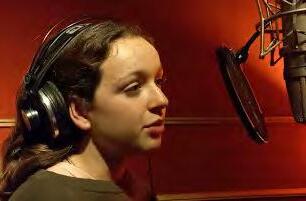
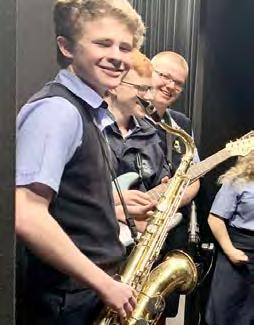
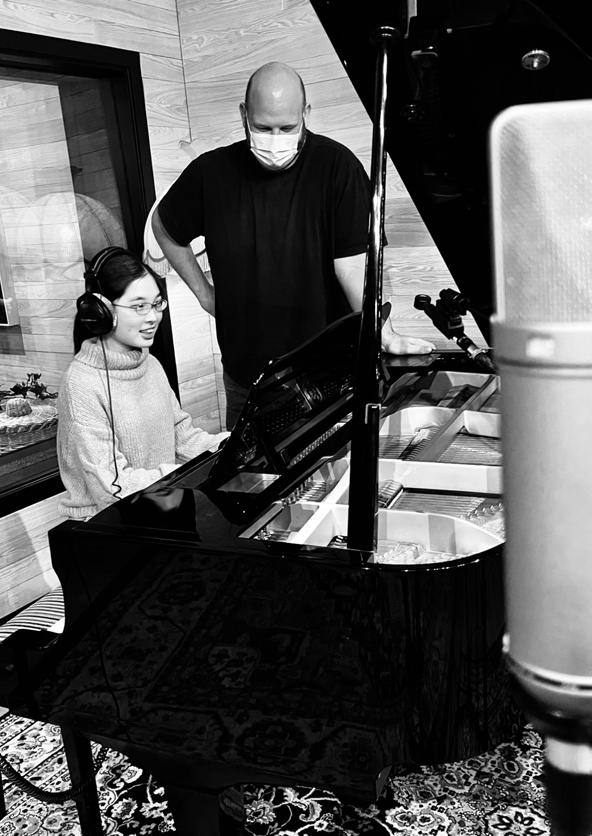
The songwriters own the copyright to the recordings (the masters) as well as, naturally, the copyright to the song – the musical work. The one thing they do, hence enabling 'Play It Strange' to place songs online, is give 'Play It Strange' the right to uplift the recordings online.
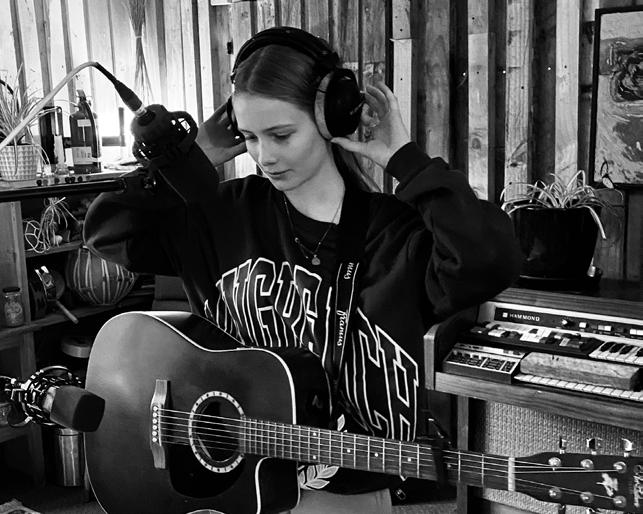
If we could SEE songs, they would be luminous trails in the breath of space. And from there, they drift down to us, and we absorb them.
In 2023 we will host four songwriting competitions. They are:
1. the Youthtown Songwriting Competition Aotearoa for years 9 – 11
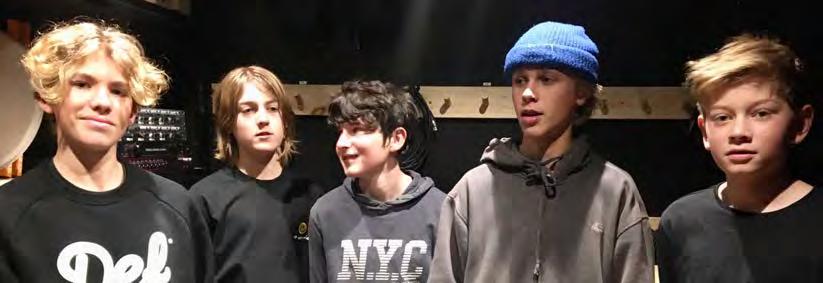
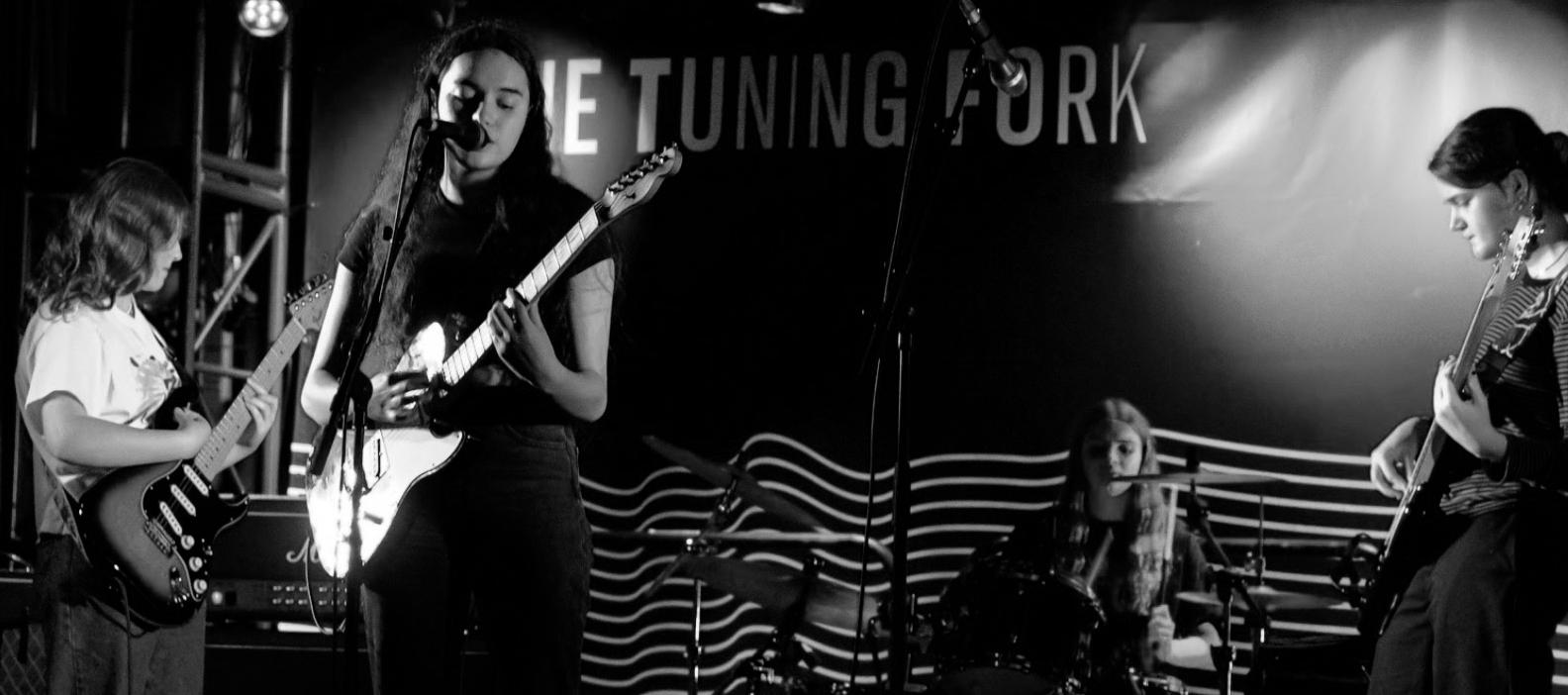
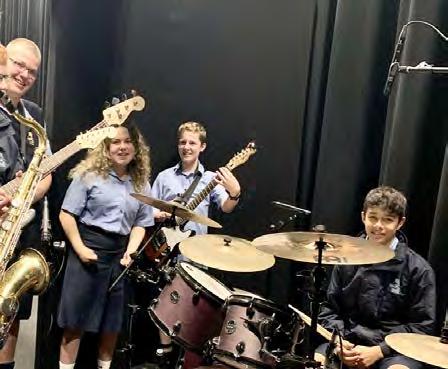
2. the Peace Song Competition with a focus on lyrics that capture the theme of ‘peace’. All ages.
3. the Lion Foundation Songwriting Competition – for all years with no specific focus apart from – excellence!!
The Lion Foundation Songwriting Competition also brings to the fore specific awards. They are:
(i) the Junior Maioha Award for the best song in te reo Māori.
BIO: Mike Chunn is well known to New Zealand musicians and music students as the bass player from Split Enz. He has also served as the General Manager of Sony Music Publishing NZ and was the Director of Operations for APRA Ltd. In 2013 Mike was awarded Companion of NZ Order of Merit for services to NZ music and Men’s Mental Health.

(ii) the David Richwhite Lyric Award for best lyrics.
(iii) the School of the Year for the school with the most number of finalists in a particular year.
All competitions are promoted through playitstrange.org.nz 'Play It Strange' as a Charitable Trust depends on funding from several entities who all see the value of songwriting as a creative pursuit. One where the imagination is paramount. They are: Lion Foundation, Trillian Trust, Foundation North, Youthtown, the Rockshop, NZ On Air, APRA/AMCOS, Soar Print and a number of generous patrons and supporters. We are very grateful to them.
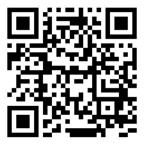
Drawing inspiration from current trends in popular music, it is probably fair to say that songwriters, including students at MAINZ, often gravitate towards diatonic-based composition. Who would blame them? Diatonic-based composition is an intuitive solution that allows for a direct path to lyrics and melody, the heart and emotion of any song if you like. Of course, plenty of songs use devices such as modal interchange and secondary dominants to introduce non-diatonic harmonic spice into their music too, but it is often the exception rather than the norm. In the second year of the Bachelor of Musical Arts degree, I teach an advanced composition class, in which we explore alternatives to diatonic composition. We sometimes move completely away from it. This article discusses that method, prescribing a different approach to melodic and harmonic relationships that I hope you enjoy.
Like many musical terms, the word ‘diatonic’ has its origins in Ancient Greece. The first part of the word ‘dia’ loosely translated means ‘across’ or ‘through’ giving the whole word the meaning of ‘through a key centre’. In the key of C, a diatonic chord progression would consist of chords drawn from C, Dm, Em, F, G, Am, Bdim or Cmaj7, Dm7, Em7, Fmaj7, G7, Am7, and Bm7(b5), and an accompanying melody would likely be based on either C major or C major pentatonic scales.
To explore alternatives to diatonic harmony, it may be useful to first consider a subdominant, dominant, and tonic premise that underpins functional harmony, defined by the regular use of chords four (or two minor), five, and one. These chords are the ‘strongest’ chords in any given key as their harmonic relationship to the tonic is closest. If you take the key of C major, then the chords in order of harmonic importance and strength are as follows: Dm7 – G7 – Cmaj7.
CHORD SCALE RELATIONSHIPS
After carefully separating chords into three distinct camps, it is necessary to deduce which notes are best suited for each one of the three types of chords, and in what capacity. A system of identifying a chord/note relationship is necessary to help guide a composer to possibilities depending on colour, emotion, vibe etc.
ROOTS AND FIFTHS/GUIDE TONES
/COLOUR TONES/’WRONG NOTES’
The following table can be used as a guide to provide clearer thinking in terms of chord/note relationships, and it breaks down the 12 chromatic tones against each of the three types of chord – minor, dominant, and major.
- DOMINANT CHORDS
C7 DEGREE ROOTS & FIFTHS GUIDE TONES COLOUR TONES 'WRONG'
b9
By breaking down notes into four distinct areas we can view note choices in a sliding scale from safe-dangerous, simple -complex, consonant-dissonant etc. Ultimately, taste and context should be your guide.
For successful application, melodies should probably be built from a combination of coloured notes, guide tones (3rds and 7ths), and roots and fifths, as variety is likely a good thing. In cooking, too much spice may ruin a meal, yet simplicity may render it boring too. If you are looking for a great example of a balanced approach to chord/note relationships in action, then check out Black Hole Sun by Soundgarden. The melody begins with coloured tones, using a major 6th, and a #11 before resolving to 3rds and 5ths at the end of the verse. Please note that ‘wrong’ notes should probably be described as ‘handle with care’ notes, being the most dissonant category, they can be problematic if used without care, but ultimately, they can still be useful. Context is everything.
Another way to look at chord/note relationships perhaps is by exploring the options available of just one note. Below is a non -exhaustive list of harmonic options that support the note F.
As you can see, there are many options available to choose from, and that is just for supporting one note!

A good way to start extending harmonic options whilst composing is using randomness, which can be a useful tool in composition to help break yourself out of learnt patterns and clichés. We tend to write the same tunes over and over, tell the same story if you like, and we should seek tools that help us explore the unknown.
In addition to randomness, it is important to build a skeleton melody first. Melodies have identifiable frameworks called a melodic skeleton, outline, or structural melody. This framework carries basic information about the harmonic (and sometimes) rhythmic flow of a melody. In analysis,
notes are heard as part of a melodic framework because they have qualities that attract the listener's attention, impress themselves on the listener's memory, and thus become important reference notes as the music unfolds in time.
Try experimenting with an economic skeletal melody that, once established, can help guide you towards a fully developed melody. For example, you may choose a single note to create a chord sequence that supports it in different ways. Below are three examples of a single note melody supported by a random but curated selection of appropriate harmony.




This composer’s toolbox method is of course just another tool to use in a composers toolbox, it is there to help a composer have more options to draw from rather than being an aesthetic imperative. As discussed, composers can fall into the trap (for better or for worse) of writing the same piece of music time and time again, as we are guided by our
own musical instincts. At times this can be a good thing as it may provide listeners with assurances of style and genre, however there may be a downside to overly predictable music too. Although this method may be prescriptive in nature, after excusing the pun, it might be, on occasion, just what the doctor ordered.
BIO: Dr Mark Baynes is Programme Leader for the Bachelor of Musical Arts degree at MAINZ, Auckland; A degree program that fosters students’ ability to find their own musical voice, culminating with the creation of a capstone project such as an album, film score or music for game audio. Mark writes regularly for NZ Musician, is a host of the 95bFM Jazz Show, and forms one half of group Goldsmith Baynes, as heard on Waiata Anthems and live at the Aotearoa Music Awards 2021. MARK
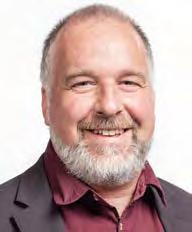
We’re pretty big
With over 400 members, MENZA is one of the largest, strongest and most organised subject associations in New Zealand. We represent a broad spectrum of music educators, from ECE to primary and secondary schools, itinerant teachers, private tutors and more.
We’re delivering on professional development In the last 12 months, over 150 members attended professional development workshops, talks or events across six different regions. That is over a third of our members benefiting from MENZA PD opportunities around the country. Later this year, we are looking to provide opportunities for teachers in Northland and Nelson, as well as the main centres – watch this space!
We provide a platform to get your events noticed. We can help you promote events, activities and performances in your area by providing FREE event listings on our website. We also encourage members to join and share events on our facebook group – because music should be heard, shared, celebrated and enjoyed! List your event today. Visit menza.co.nz/events
We’re making some noise on behalf of music education. In previous years, our advocacy work for primary education saw MENZA interviewed on Radio New Zealand and featured in the Dominion Post and New Zealand Herald. We are proud of our advocacy work for instrumental music teachers, working with the IRMT to develop a teacher education refresher course tailored for ITMs that is now more affordable, relevant and manageable for all concerned.
We’re a powerful voice at the table. As the official subject association for music education, MENZA nominates and is represented by members on MOE, NZQA, PPTA and other advisory or regulatory education review groups. We listen to our members and advocate on your behalf to ensure that music education in New Zealand can thrive at all levels, all over the country.
We recognise the unique landscape of music education in Aotearoa. That’s why we provide local content, resources, research and teaching tools, written by New Zealanders with kiwi kids in mind. Our involvement in Hook Line and Singalong ensures kiwi songs are transcribed and shared to be used as a resource to sing, sign in NZSL and strum along to on your ukulele.
From practical tips on organising a recital or enjoying your school production, to researched articles on music psychology and pedagogy, or thought provoking personal insights on creativity, inclusiveness and excellence, Tune Me In provides a platform to share teaching resources, knowledge and expertise relevant to music education in Aotearoa.
Our members are our greatest asset.
MENZA represents a committed network of music specialists and educators, many of whom give up their time and energy to support the music education community through presenting workshops, organising and assisting with music festivals and events, or simply by sharing their knowledge, ideas and experiences with other members. As a MENZA member, you are part of a supportive community of engaged, enthusiastic educators to learn from, collaborate with and celebrate music in all its forms.
We celebrate achievement - and work hard to make sure the unsung heroes of the music education community are recognised and always delight when one of our nominations makes it through to be recognised in the New Year’s and Queen’s Birthday Honours.
Spread the word. The more members we have, the wider your network of support and the greater the opportunities for collaboration and shared expertise. By representing a large and diverse community of music educators, we can stand up, be counted and influence change. If you know somebody who might benefit from membership, or may have something to offer other members, spread the word. Membership starts from as little as $34.50 per year.
Get your event out there! List your event on the MENZA website and share it with over 400 engaged, enthusiastic music education professionals at menza.co.nz/events. Get involved. If you would like to help bring professional development opportunities to your area, have expertise you wish to share, or want to discuss how you can contribute to New Zealand’s music education community, we would love to hear from you. You can contact us at admin@menza.co.nz and we will be in touch. Do you know someone who would appreciate becoming a MENZA member? Gift subscriptions are also available for just $34.50 (Incl. GST). Email admin@menza.co.nz for more information.
The New Zealand Ukulele Trust | Te Rūnanga Ukurere
o Aotearoa is a volunteer-run charity inspired by Bill Sevesi’s dream that every child would learn to play the ukulele. For over 15 years, the Trust has been dedicated to improving access to music for New Zealand children.
Our core music education programme is the Kiwileles programme which celebrated 15 years in 2021. Through this programme, we provide schools with an online teaching resource - the Kiwileles Songbank. The song bank contains graded songs and waiata specifically chosen and arranged by educators and musicians for NZ tamariki with something to suit all abilities. Musical styles are varied, and riffs, chords, words, scales, and notes about the music are included. User -friendly, engaging, and well-supported by the NZ Ukulele Trust, these resources will support teachers who may have never picked up an instrument before with the confidence to incorporate music into their classroom.
We at NZUT are absolutely delighted that teachers have stepped up to be Kiwilele Uke Hub leaders across the motu - including six larger Kiwilele Jams being planned in Auckland in November. Due to the past three major festivals being cancelled, our funders have allowed us to have Suzy Cato as the MC for these Auckland Events. If you are an Auckland school, or if you would like to host other schools or join in with one of the dozens of planned Kiwilele Jams, get in touch with our administrator Christina (admin@nzukulele.org.nz).
Moving toward these smaller, bespoke localised Kiwileles Jams has been a popular move, and we are delighted to report that membership of our Kiwileles programme has grown both in size and geographic reach in the past couple of years. Over a third of registrations for 2022 are from schools new to the Kiwileles Programme, and we now have over 5,000 participating right across Aotearoa (even the Chatham Islands!).
We couldn’t do what we do without the generous support of our trustees, teachers, Uke Hub Leaders, and our sponsors. We would like to thank Kala Brand Music and Lyn McAllister Music, who sponsor our Ukes in Schools Programme and deliver over 2,000 free ukuleles to schools to kick-start their ukulele journey.

We do need your help! Please get in touch if you would be happy to organise and host a local Kiwilele Jam - we may even be able to help you with a teacher release day and a $50 prezzie card to ensure you are not out of pocket.
We are also looking for trustees to join the New Zealand Ukulele Trust - this involves meeting every six weeks via zoom with other passionate music educators such as yourselves who believe all children have the right to access a quality music education programme. Please contact our administrator Christina admin@nzukulele.org.nz if you want to be part of this important work. For more information, go to our website nzukulele.org.nz

- Co-chairs of New Zealand Ukulele Trust. Originally from Wellington, Masina now calls Taranaki home. She loves how the ukulele can be such a magically accessible instrument and how the NZ Ukulele Trust is helping kids across Aotearoa engage with music. Currently a stayat-home māmā, Masina spends most of her time chasing her 18-month-old around the garden (ukulele in hand, of course).
I tipu ake ahau ki Maniatoto, kei te noho ahau ki Whakatū inaianei, ko Tim Carson toku ingoa. Inspired by his work wife and mentor Maria Winder, Tim believes that every child in Aotearoa, New Zealand, should have access to a quality music education. He is an EdD candidate investigating how the ukulele can foster selfregulated learning in the primary classroom.

Within children’s everyday experiences listening, dancing, and singing to waiata, children grow familiar with musical elements such as the beat and rhythm. Beat-making is of great benefit to children’s development from infancy to preschool ages and is a wonderfully fun and collaborative form of musical play in the Early Childhood Education setting. Te Whāriki, the Early Childhood Education curriculum of Aotearoa New Zealand, outlines kotahitanga, holistic development, as one of four key learning areas of focus in ECE settings. This article outlines how beat-making can support holistic learning and provides several teacher -led experiences for ākonga.
Creating a beat is a cognitively complex task. It requires the child to develop the ability to use their auditory processing while listening to the beat and simultaneously move their body in ways to be in time with others. Research outlines the benefits of such musical activities for young children (Collins, 2021). As part of last year's MENZA conference, Dr. Anita Collins shared her neuroscience research into the brain while making music. She discussed the cognitive process of maintaining a beat, which suggests children develop executive functions such as problem-solving, managing emotions, empathy, attention, memory, impulse (inhibitory) control, persistence, and resilience. It is important to mention that in ECE settings, it is not about children perfecting the musical skill of keeping a beat. However, the activity is a way of promoting children’s foundational knowledge of music while also supporting their cognitive development.
Beats can be a useful tool to intrigue tamariki and mark clear changes in daily routines, such as moving from free play to group meeting times, mat time, or hui. Physically, ākonga use their bodies in dynamic ways, developing coordination and gross motor skills. Using their own bodies to create sounds empowers children’s physical self-awareness and promotes opportunities for this to be investigated further.
Beat-making can be incorporated in a multitude of ways. Beats can be added to any shared waiata by simply tapping your waewae (legs) in time to the melody.
From my experiences working in an infant and toddler setting, the more kaiako do this ourselves when we sing, the more tamariki copy and join in creating the beat. There is an incredibly social and collaborative nature to beat-making. Particularly for our youngest ākonga, tapping or creating the beat turns waiata into an full-embodied experience like popular action songs such as “Hammer-Hammer”.
As children develop beat-making skills, we can increase the complexity of the beat, including other body percussion ideas.
Examples could include leg-clap-leg-clap, floor-leg-clap-leg etc. Another way of adding complexity and interest to beatmaking is changing the tempo. Using the waiata “Come meet me on the mat”, I begin with a lively walking pace for one or two repeats, which allows most of the children to come over and join in. Then, I will pick up the pace. When children are settling on the mat I slow it down to half the original tempo.
It is important that as the kaiako, we provide tamariki with verbal instruction and support for what we are doing with the beat. Before starting a waiata, kaiako could say, “let’s get our beat ready”. Other instructions could include, “let’s speed up our beat” or “now, slow it down”. Statements such as these allow ākonga to actively learn about the elements of music in a collaborative and fun context.
Finally, these beat-making experiences are teacher-led musical play. We can also consider how we can recognise child-led beat-making experiences and how this may appear within children’s spontaneous play. A few examples could include a child tapping in a consistent tempo or simply swaying in time to the music. In these moments, we can make children aware by acknowledging their beat-making. Then, we can consider ways to offer experiences that empower children to continue exploring this musically. Some ideas could include introducing percussion instruments where children can investigate beat and rhythm or offering sound provocations such as a soundboard.
BIO: Greta works as an Infant and Toddler Head Teacher in West Auckland. Previously, she was a performing singer-songwriter researching the links between vocal and songwriting teaching methods. While studying, she began working in ECE and found a passion for promoting musical play for our youngest ākonga (learners). She values child-led, play-based musical learning opportunities centred around singing, children’s improvised instrumental explorations and sound investigations. One of her overarching focuses is promoting the inherently musical nature of infants, toddlers and young children to ECE kaiako.
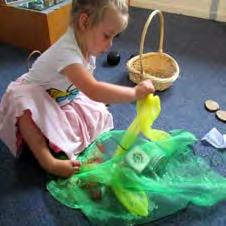
Dr. Helen Pritchard is an early childhood practitioner, lecturer with Manukau Institute of Technology/Te Pūkenga and academic researcher with Workforce Development.
My doctoral research identifies and theorises the nature of transformative experience through a variety of Expressive Arts in early childhood settings. The research draws predominantly on John Dewey’s writings, with Art as Experience (1934/2005) formulating the pedagogical basis for my work.
My intention is to make explicit the term experience and to consider what makes an experience transformative to a degree that can influence teacher's practice in the arts. Within this research, the children’s experiences must produce change or transformation in perceptions and knowledge for them to be regarded as meaningful, and relevant to their everyday lives and curiosity.
The teacher as artist sees each connection of doing and undergoing in relation to the whole that they desire the children to experience. They must think in terms of poetic qualities rather than symbols and words.
Play forms an important mode of experience for the child. The joy of knowledge, skills and understanding that comes from Play is transformed into something of meaning, a certain kind of truth for the child. Children’s experiences often begin as imitation, but mimesis is not simply a second version or copy, the children’s recognition of the essence of an aesthetic (or artistic) event becomes a new experience. When meaning is recognised within the work, they achieve a kind of selfrepresentation and this is the beginning of the development of an aesthetic attitude.
Data collection included observations of children engaging in the arts at five early childhood centres in Auckland, New Zealand. The data helped to identify emerging themes, and highlights how artistic and affective dimensions within arts experiences enable children to encounter new learning challenges and concepts. A phenomenological approach was used to examine the children’s lived experiences and explore the emergent themes.
Ella’s interest in telling stories caught my attention. She came into the storytelling space, watched the other children for a while and then started gathering materials from the heuristic play resources. She specifically laid them out and began to recite the nursery rhyme Mary, Mary Quite Contrary as she put the assorted items under a green silky chiffon scarf. Ella knew the nursery rhyme well because her teachers had used it at mat time, but she had not sung the song at the centre for some time and so her teachers were amazed that Ella could recall the rhyme so well after so long. Collected experiences developed over time can produce further transformation in how a child thinks, enacts and comes to know.
Teuila had discovered a space for herself and her friends by holding hands with a group of children and forming a circle. She engaged their participation in the song Ring-a-Roses. As they held hands together and walked in a circle, the children coordinated their movements together. When Teuila sang All fall down, she laughed as her friends all fell to the ground together. Teuila became a dance-maker, an active agent, drawn to respond to music through movement, through her senses - hearing, seeing, and feeling - accompanied with experimental vocalisation and body movement.

Penina had been selected with a team of boys to perform the Samoan haka. He needed to learn the words by heart, chant them rhythmically and enact the moves. His actions included: slapping hands on knees, puffing out his chest, bending his knees and stomping his feet as hard as possible whilst chanting the refrain. Penina summoned up amazing energy for the dance. His actions were vigorous, and he accompanied the rhythmic chant with all the moves. I saw Penina develop his skills and ability to express the emotion of this music. He inspired many other children who watched and joined in this performance. On graduation night, Penina performed the Manu Siva Tau, perfectly demonstrating all the moves and actions.
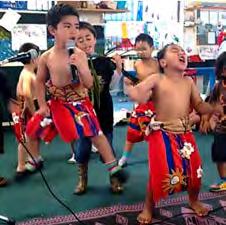
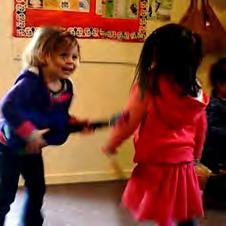
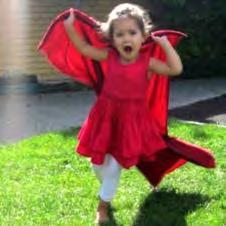
Ella sat with a group of six children gathered around a piece of fabric, while their teacher sang and strummed on her ukulele. Ella strummed the ukulele while singing the well-known children’s song The Wheels on the Bus. Her teacher sang and played very slowly, coordinating her singing as she changed chords. Some children were strumming their ukuleles, while others were intent on feeling the beat using both hands to pat the drums to the rhythm of the words: “up and down” (ta-ta-ta rv est).
Ella’s engagement in playing music heightened her awareness of the characteristics of instruments as a form of expression.
Teuila decided to make use of the fabric pieces for her Elsa cape Many children watched as she performed this dance and expressed her joy in the song. Teuila utilised the relationship between music and gesture, outstretching her arms for the most intense moment, while singing the propelling refrain, Let It Go! At the same time, she spun around, twirling her cape in a full circle. She extended her gestures using the coloured capes. The cape disrupted the original flow, modulating the action into a more complex series of movements. Her costumes and movements showed transformation of energy into thoughtful action. She used dance with conscious intent; she explored new potentials, initiating dance and sharing her joy with children.
A visiting musician invited the children to listen, feel and respond (in this instance, as sleepy fish) Shared songs about the sea and fish were often improvised ‘in the moment’, building on children’s prior experiences. Music and movement enabled the teachers to join the children and re-experience the spontaneous, creative qualities which are seen when children instinctively play. Through their bodies, the children extended their percepts to musical concepts of tempo (fast/slow) dynamics (loud/soft), duration (long/short) pitch (high/low).

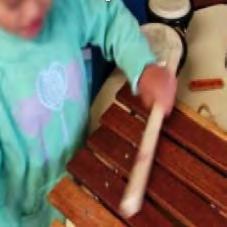
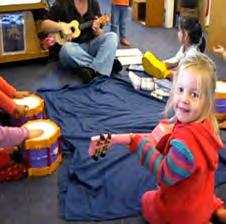
The essence of the musical experience is to take the beauty in music to the classroom and cultivate children’s power to listen, to feel and respond. When teachers (as artists) help children to be creative, they will also learn to create for themselves. Being prepared for children’s spontaneity and invention encourages these same qualities by enabling children’s input into the musical story through their imaginative responses.
The repetitive refrain “Run, run, run, as fast as you can, you can’t catch me I’m the Gingerbread Man” is very catchy. Rosie was motivated to create her own experiences through music and movement. She loved to sing and dance and often asked for a ukulele. The next day the teachers set up a cooking activity and the children made their own gingerbread dough. New ideas surfaced through her interaction with materials, and she created a skateboard as a means for the Gingerbread Man to escape a fox. Rosie used energy of purpose and mimesis in the pretend gingerbread dough, looking like the real thing —there was, therefore, a kind of truth about her activity. She was empowered by the realism of her creation; therefore, this experience was transforming. Rosie recreated the story through singing, playing, dancing and modelling.
In the Aonga Amata, Sefina was attracted to a wooden xylophone, exploring its properties by first removing the bars to inspect its shape and attributes. As she replaced the bar where she’d found it, she picked up a beater to experiment with the available sounds. She was able to control the beater and listened to the beautiful sounds she made by running the beater across the bars. Sefina savoured a descending glissando melody and repeated this several times. She experimented with the affordances of this instrument, discovering rhythm and melody by being creative, expressive, and imaginative. She used the beater to run back the other way, creating an ascending scale and then repeated a rhythm (ta ti-ti ta), discovering a pentatonic melody (do re me so la), back and forth. The aesthetic nature of her composition, with its melodic balance, seemed to entice her further and she sat down on the chair to continue playing.
For Dewey, an experience is an interaction between the child and the environment which, when it is carried to the full, is “transformation into participation and communication” (Dewey, 1934/2005, p.22).
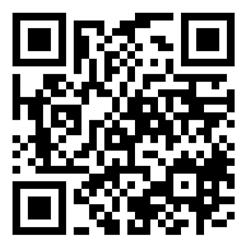
BIO: Dr. Helen Pritchard is an early childhood practitioner, lecturer with Manukau Institute of Technology/ Te Pūkenga and academic researcher with Workforce Development. My doctoral research identifies and theorises the nature of transformative experience through a variety of Expressive Arts in early childhood settings. The research draws predominantly on John Dewey’s writings, with Art as Experience (1934/2005) formulating the pedagogical basis for my work.
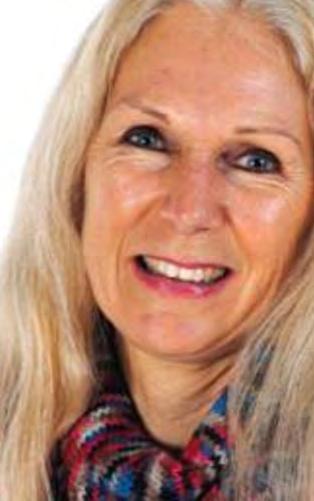
It's only March, and you've been asked if the jazz band will play for the opening of an event.
The problem is that some of my new players only know a couple of notes as they only just started their first lessons. We've only started two charts.
Do you say - sorry we won't be ready until at least next term?
Do you say - sure, any performance is a good opportunity. Do you say - Yes, we can make that happen successfully!
“Sorry, we won't be ready until at least next term.”
I’ve seen this lead to, “We’re still not ready, they can just do a small in-school performance. I don’t want them to be shamed compared to other schools’ groups”. The group can end up with very few performances and low self-esteem or frustration among players who want to be given chances to grow more in their music performance experience and ability.
“Sure, any performance is a good opportunity.”
There’s a risk of it being a negative experience because the band wasn't ready. Perhaps some students lose pride and motivation in being in the “not-yet-ready” group, or even lose interest in playing music in general after they see the video of the performance a parent took. Perhaps the organisers of the event decide not to ask your school group to perform again, not realising the potential they have. Of course, there will be some
students and parents who love the experience regardless aof how the performance sounds.

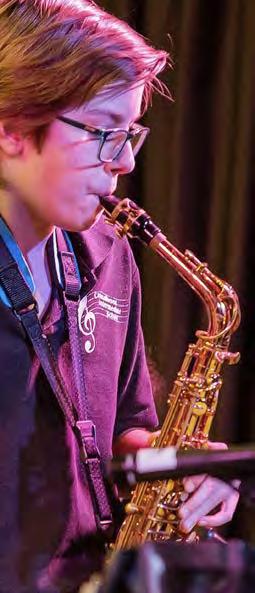
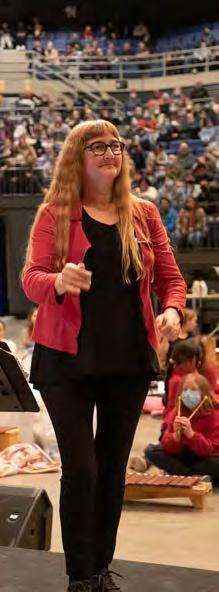
“Yes, we can make that happen successfully!”
A few years ago, when we were asked to perform in March for a big public event, we trialled a new model for our jazz band that has become a very successful tradition. We invited our previous year’s band to do the gig - we called it a “reunion gig”. Meanwhile, we prepared our new band to learn as much as feasible of one or two of last year’s easier repertoire, and I concentrated on teaching our new band one new easy piece (albeit with some parts missing etc).
For us, being an intermediate school, there’s usually between one and eight Year 8 second-year players who know the previous year’s repertoire. It’s always tricky for them at the start of each year because suddenly the band they got used to playing with are half complete beginners, which can feel discouraging. So, knowing they will get to play with last year’s band in term one is something they look forward to a lot! As for the new players, the rules are simple. Always play the last note. Or at least hold your instrument as though you are playing it (if you forget how to play that note suddenly). Follow through and always navigate their music part, play the notes they can, and enjoy the sensation of the band for the other bars. This is hugely important because the students get the feeling and sound of what their new band is aiming for and what it will
A new year, a new band, new players and the experienced players have all moved on!
sound like. They are dressed in uniform and a real part of the performance.
Each year is obviously a bit different, usually with double-ups of horns and double-ups or swap-arounds within the rhythm section. Often everyone (including the newbies) plays a short 2-bar solo within a piece, which normalises this aspect of being in a band (even if just on two notes). If we have managed to mostly learn one new chart, it creates a good challenge and freshness for the old band to learn and play with the new band. We have also done an early-in-the-year gig by jumping into a community big band gig and playing a couple of charts with a friendly adult band. The value to the students and entertainment for the families/audience is huge, and it is highly motivating for the new band. The bar is set, and the new students rise to it quickly over the next few weeks. It is great to see the pride in the performance and group and the motivation and commitment this gives.
Our school year for jazz bands now ends in March or April of the following year, and it has become a wonderful and valuable tradition. Admittedly this year’s term one was very tricky with rehearsals needing to be in four different rooms connected via video link due to Covid restrictions and much illness in term two. Still, we did squeeze in a couple of successful combined performances in May!
Students will quickly learn commitment, teamwork, and professional standards of behaviour if they are given opportunities to play in public, especially doing a tour later in the year. Our first combined gig of the year is usually as part of a community outdoor event. Gigs also give students deadlines to learn music and the chance to experience different contexts and audiences. Try a band camp (or band day!) that includes a performance.
Tours can pack multiple experiences into a short time. Tours we have enjoyed (later in the year) include going to festivals such as the MusicWorks National Ensemble Festival Aotearoa musicworks.co.nz/mefa-home/ (formerly WeBO), performing at local schools or schools in another region, going around several local Early Childhood Centres over a couple of days (with interactive educational aspects!), and even performing at non-music festivals such as the Oamaru Steampunk festival. Performances at lifestyle/retirement villages later in the year include repertoire that the audience will know.
OTHER TIPS TO MAKE THAT FIRST PERFORMANCE A HIT:
• Choose repertoire that matches the students’ current abilities. For example - if you have strong singers, make sure you have repertoire that features them in the right key for their voice.
BIO: Judith (Mus B hons, LAIRMT) is the Jazz Programme director at Chisnallwood Intermediate and a jazz director at Shirley Boys High. She was music HOD at Chisnallwood for 23 years running multiple performance groups and music technology. She is co-chair of Music Education Canterbury, co-music director of “Strum Strike and Blow”, and is on the organising committee for the Christchurch Big Band Festival. She plays in two Big Bands.
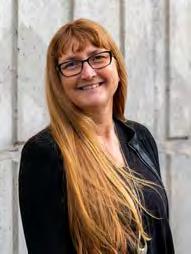
• Choose repertoire that your bass player can at least play the first note of every bar and every chord change correctly.
• Choose repertoire that at least someone in the band can play the head for! I always include a 12-bar blues chart so students get used to the form, sound, and changes.
• Teach tuning and intonation from the very beginning, so it’s normal to respond to and correct.
• Importantly have fun, and as the band director, respond to all the good moments in the music immediately!
The Christchurch Big Band festival is an opportunity during the October Labour Weekend for any Big Band (from professional to beginner bands) to participate in a full weekend of Big Band performances, workshops and more. It is in its 16th year and runs annually in Christchurch. If you have a jazz big band of any age, the event provides lots of opportunities to see what others are doing, share ideas and perform. bigbandfest.org.nz
Check out the NZ Jazz Foundation website, where jazz director workshops are advertised and run by Rodger Fox and Dave Lisik alongside student workshops. This year it is being run from Dec 11-16 in Wellington. nzjazzfoundation.com/educatorworkshops
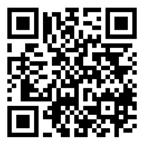

Or hours spent learning a tricky line from a piece of music we had to master before an exam or performance.
Or the stopwatch marking down the minutes for practise time, ensuring we went over our pieces and our scales and diligently marked off our theory.
There is a particular kind of triumph that emerges from these moments. They are, as many of us can attest to, a crucial part of learning anything new. Committing to mastering an instrument is, for most of us, always going to come with a certain amount of angst amongst the joy. There will always be moments that are less about enjoying music and more about putting up with the monotony and the relentless nature of mastering anything challenging. But what I am most interested in is the other part. The part about play.
The part that is not a challenge. The part that is joyful and inspiring and moves us to feeling connected and emotional simply because we are creating music. The part that is quite unlike anything else in this respect, because it allows us to express ourselves and feel totally lost and included all at the same time.
I am interested in adults who continue to play and find joy in playing instruments beyond the exam years. I am interested in those adults who continue to find this joy long after their parents have put away the stopwatch or star chart for daily practise and years after they have stopped having weekly lessons from a teacher.

I think that it is crucial that teachers remember we are laying the foundation of music for life, and inspiring a love of music, and a deep understanding of that music, which lasts well beyond the next term or two.
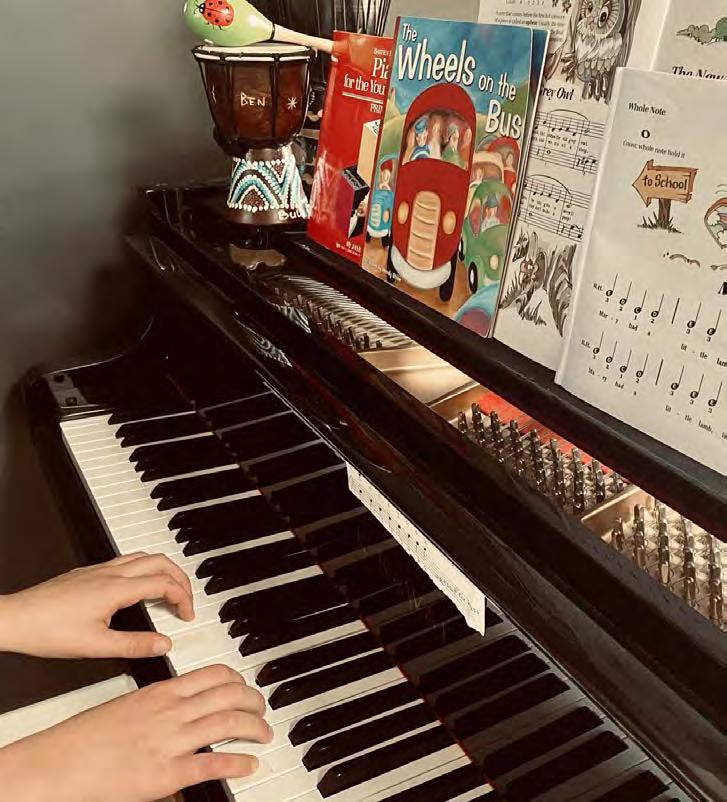
Many of us have memories of sitting at a piano or other instrument in tears, feeling frustrated and inept and wishing away the lesson or practise.
I was working with a 7 year old piano student this term who asked me what the black notes were for. I asked her to try switching out her 3rd note for the black note when she played her next piece to me, and her eyes lit up when she heard the minor scale emerge. We went on to forgo the plan for our lesson and instead explored the blues scale and how we can play with music to make it sound cheeky or melancholy or humorous. She was so engaged and excited that she came back the following week with her own song that she’d created using the blues notes. The child that had struggled to get her head around reading music had no trouble writing out her 2-bar piece of music and even included the little flat sign. I have no doubt that she has a new motivation to continue her practise each week. I think that music is a part of all of us, yet often it can become something exclusive that exists for those talented enough to really master an instrument or those with voices that get them into choirs.
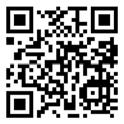
The ability to tease and play and create joy is one that these musicians excelled at.
The reason my children have music lessons, and something that I keep in mind when I am teaching music, is not because I see music in their career, although that is wonderful if it is. I do not necessarily mind if they join orchestras and bands although I would love them to experience playing as part of a group for the feeling it brings. I do not know if they will sit exams, but I hope they might.
For me, the most important thing is that my children and students will be playing music for the rest of their lives, and gaining the benefits of this long after my influence fades.
I keep their joy and interest at the forefront of every lesson, and if that means we focus on something left-field one day, or spend a day improvising rather than practising scales, or find chord charts on Google to learn songs I’ve never heard of, or spend a lesson writing and experimenting then, to me, that is a lesson well spent and not a minute wasted.
I love that I often find my children playing instruments at home. They experiment and improvise and call out to each other when they discover something intriguing and show off little melodies they have picked up from a movie. They can be painful to convince to practise their music books, but they sit and play on their own at least once a day in a way that I can see completely engages them.
I wonder if this starts very young, when children are learning about who they are, and if we need to be really mindful of creating spaces where music exists purely for the joy of it. This includes within music lessons, so that children who are learning instruments become adults who play instruments – and they continue to do so whether they are highly talented or not. Some of the best musicians I have ever had the pleasure of performing alongside in the past, as a lead vocalist, have not been the most highly accomplished players. The difference between a stand out show with a crowd going wild and a less engaged audience was never about the expertise of the musicians, in my personal years of experience. It always, without fail, came down to their ability to be playful and joyful and enjoy the experience of playing for an audience who responded to their music.
My wish is that everyone who learns an instrument has the opportunity to fall in love with music alongside their lessons. I think it can be easier said than done when we have short lesson times, expectant parents and exam pieces to get ready, but if we are vocal and confident in our belief that playing music also means playing WITH music ...we become advocates for students who are passionate musicians for the rest of their lives and I can’t think of a greater gift.
BIO: Louise is the Christchurch City Council Play Advocate, a role that sees her influence and support play in all its forms across the city. She worked as a Pediatric Music Specialist in Early Intervention with children with disabilities and alongside Julie Wylie in her music school as as part of her work supporting parents, teachers and therapists to understand music and use musical play tools effectively. Louise also teaches piano to children under the age of 10, is a professional vocalist and has three sons who all love music.
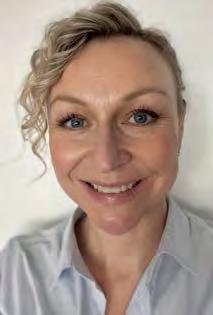
Too often, I have come across adults in my work who are convinced they are “not musical” or rely on other teachers to provide musical components to their early childhood centres or classrooms because music is “not their thing.”
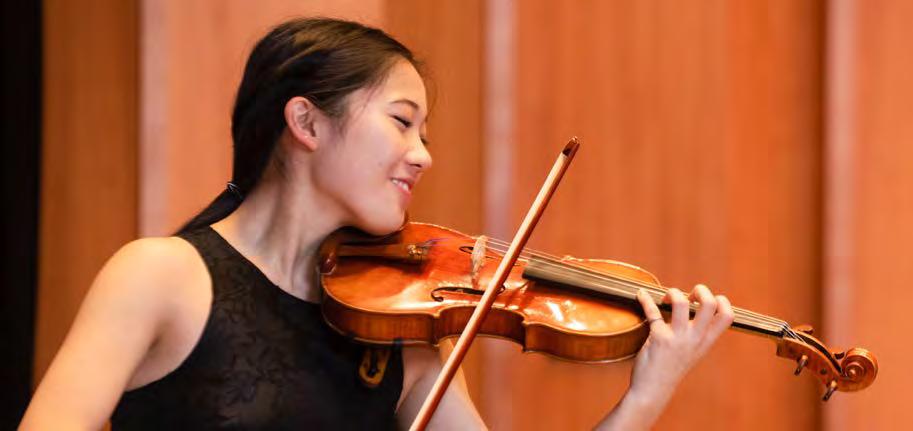
From those starting out on their musical journey through discovery and exploration to those who arrive at Rangi Ruru with high levels of prior learning, motivation, and a full commitment to their music learning.
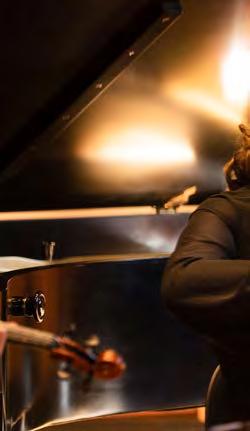
In my role as Director of Music, I have been privileged to work alongside many talented young musicians. I have been part of a team that has guided these students in their musical journeys through exposure to a wide range of music, giving them breadth as well as the depth of knowledge and critical thinking skills to enable them to succeed in the demanding and highly competitive NZQA Music Scholarship examination – particularly as performers. It goes without saying that a high level of technical proficiency on instrument/voice is essential for this examination, along with natural musicality and a desire to work hard to reach the highest levels of performance and musical understanding that each individual can. As an educator, I do not have a ‘formula’ that guarantees a portfolio be awarded a Scholarship in Music. However, below are some areas, all interrelated, that I consider with students and their instrumental/vocal teachers in support of scholarship performance portfolios. Many of the ideas below can easily be adapted to portfolios in composition or musicology.
1. Informally identify possible candidates early – from Year 9. Ensure that these students receive regular lessons and develop good practice habits. Encourage them to become involved in the music programme outside of their ‘specialist’ area – Orchestra, Jazz Band, Choirs, Chamber Music, Percussion Ensembles, Rock Bands, Musical Theatre, composition, songwriting, attendance at concerts and gigs, and performing opportunities that are both formal and informal. Support them to make music a habit – something they are involved with in some form most, if not every, day.
2. Start talking about the possibility of Scholarship with those identified from around Year 11 – sow the seed. Some who demonstrate musical maturity may wish to submit a portfolio in Year 12, others wait until Year 13.
3. Individual lessons are the ideal. Most of our students who have won scholarships are fortunate enough to access private lessons. However, I believe that motivated and high-achieving students can succeed in Scholarship through a well-resourced and targeted ITM and Music curriculum programme within schools.
4. Involve the instrumental/vocal teacher in the planning of the programme for Scholarship. Establish a good relationship with this teacher in the years before a scholarship portfolio submission so that as a curriculum teacher, you are clear on what the goals are for each student.
5. Practice performing from Year 9 in a variety of formal and informal situations. After every performance, we support active reflection. In Years 9 and 10, this is informal – through individual and class constructive feedback. From NCEA Level 1, all our students are required to reflect on their performances in a written format – identifying aspects that went well and next steps for learning in areas of accuracy, technique, musicianship, and communication /presentation. This provides a solid foundation for the requirements of an expanded reflection in areas of technique, musicianship, and style, as required in the scholarship critical reflective study.
6. Assisting students to develop good practice habits is essential, with development over a long period of time. At Rangi, practice techniques and habits are discussed and explored with students – there are some great online resources available. Students are encouraged to set both short- and long-term goals, to evaluate and reframe as necessary, and to keep practice diaries, starting from Year 9.
Rangi Ruru Girls’ School in Christchurch has a vibrant, well -resourced music department with a wide range of learners.
BIO: Janet Kingsbury has been Director of Music at Rangi Ruru Girls’ School in Christchurch since 2003. She has a particular interest and strength in chamber music, orchestral music, musical theatre direction – including musically directing West Side Story, Cats, Evita and Jesus Christ Superstar – and academic music as well. In 2017 she received an ISNZ honours award for service to Music Education.
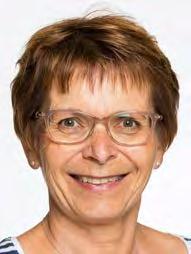
Rangi Ruru students have enjoyed success in NZQA scholarship music, including three Top Scholar Awards and several Outstanding Scholar awards in recent years, in addition to recognition in national secondary school competitions and representation in the NZSO National Youth Orchestra, NZ Secondary Schools’ Symphony Orchestra and NZ Secondary Students’ Choir.

7. The 3000-word critical reflective study is challenging. Candidates must know about music – have strong musical literacy skills, know how to analyse, know about the genres represented, plus demonstrate high levels of critical and reflective thinking along with superior formal written language conventions. There should be strong evidence of an ability to demonstrate independent thought, to be reflective, to research, process, synthesise, extrapolate, and theorise.
8. The critical reflective study is a formal piece of writing which should have a professional presentation. Screenshots of musical examples should be clearly identified and annotated, relevant to the points under discussion. Copies of scores (with accompaniment as appropriate) should be included. It is important to note that the document is a reflection on performance and process, not an analysis of the music. However, the ability to analyse to support critical reflection is an important part of the process.
9. Students are advised to keep a notebook/diary/recording of discussions and decisions made in lessons – so that when they come to write their critical reflective study, they have an accurate record of the year’s lessons. This includes thoughts on repertoire choice, programming decisions, interpretive/stylistic matters, and the more usual technical and musical aspects of playing. Students should also keep a diary of performances, either online or live, that they have listened to as part of their portfolio presentation. From these, make comparisons, working out how to assimilate aspects they identify with into their own playing.
10. Perform as much as possible – anywhere, for anyone, in any genre/combination. Students need to know what it feels like to put themselves under pressure, how they react to pressure, and how to learn from performance experiences – from those that went well to those that may not have come up to expectations for various reasons.
11. Scholarship students at Rangi have access to mental performance coaching. This has proved to be very useful and

indeed acknowledged in several successful critical reflective studies. Advice and guidance on how to cope with nerves, selfdoubt, and anxiety, as well as assistance with time management, planning, and goal setting is invaluable in assisting students in performing at their best.
12. Students are supported with programme planning to assist them in representing themselves at their best within the appropriate genre/style. It is important to choose repertoire that is significant and important for their instrument/voice. Time limits should be very carefully considered and adhered to.
13. A planned schedule of rehearsals with their accompanist is important. Support students to consider and reflect on this relationship, including how issues that inevitably arise working with an accompanist are approached and solved.
14. Appropriate performance presentation appropriate to the genre is essential – including aspects such as appropriate venue, dress, walking on and off stage, and taking time to settle before performing.
15. The recording should be of the highest quality possible, especially audio. The performance should be a real performance situation with an audience – the audience is the final ‘ingredient’ in any performance.
16. Students need to be in command of their performance on the day. The music should be prepared over a long period of time and known so well that the student can be in the moment whilst performing – being spontaneous and expressing the intent of the music to the audience.
This is not an exhaustive list. Hopefully, there will be some areas from the above points that provide opportunities for further development and adaptation to suit the students who might be considering entering for NZQA Music Scholarship in your school.
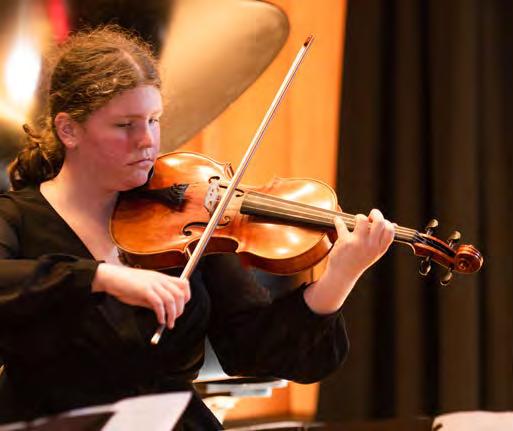
The Specialist Music Programme was established in 1996. It was the brainchild of Hugh Stevenson, Burnside HOD Music at the time, supported by colleagues from Westburn Primary School and the University of Canterbury School of Music; some years later, the UC Teachers’ College joined the partnership.
The programme is approved by the Ministry of Education as having specialist status, the only one of its kind in New Zealand, and therefore successful applicants can gain entry to Burnside High School from anywhere in the country, bypassing the school’s zone restrictions, in return for a minimum four-year-long commitment.
The programme’s aim is to provide a high-level music education for musically gifted students, particularly at primary and secondary levels, and is overseen by a council of representatives from each partner institution. Back in 1996, the initial cohort of Burnside SMP students comprised 29 students, however the programme has grown over the years and now has around 100 members, divided evenly across years 9-13. Entry is by audition; each year we welcome between 20-25 new members.
The programme follows a junior conservatoire style structure in its delivery, but within the confines of mainstream secondary education system – never an easy task! All SMP students therefore follow the same curriculum as the rest of the school, but SMP activities run outside of school hours and the course content looks like this:
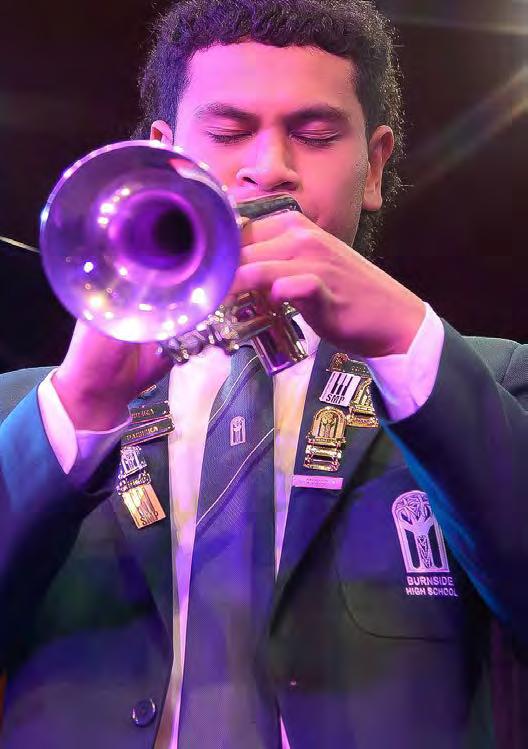

• A weekly private lesson on their specialist instrument with a specialist tutor who can support the aims and standards of the programme.
• A weekly masterclass after school; these are in mixed age but instrument – specific groups and led by a specialist tutor – our SMP tutors are all highly qualified and experienced professional performers.
• Chamber Music for all SMP instrumentalists; we have around 20 chamber music groups running each year; all of them perform at the NZCT Chamber Music Contest.
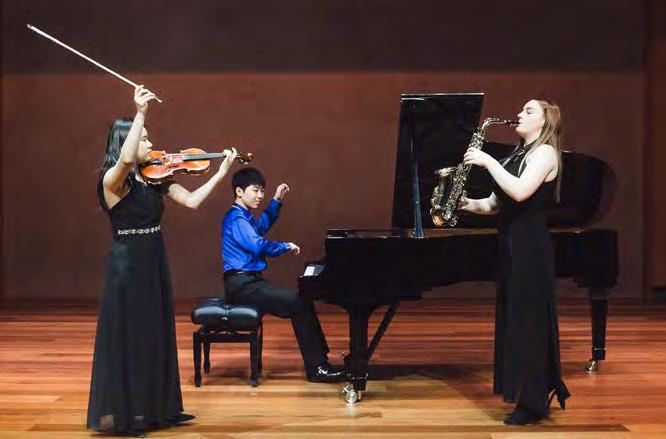

• Mid-year and end-of-year solo recitals.
• Special “one-off” SMP masterclasses and projects; in 2022 we ran a masterclass and chamber music workshop day with Te Koki Trio; a collaborative project with Prof. Mark Menzies and UC students; jazz clinics and
BIO: A proud Yorkshireman and Graduate of the Royal Northern College of Music in Manchester, Chris has worked in the Music Department at Burnside High School in Christchurch since 2010. In England, Chris worked as a freelance trombonist with orchestras such as the BBC Philharmonic, Royal Liverpool Philharmonic, Opera North, Hallé Orchestra, and in session work for the BBC and Granada TV. In addition to his work in education, Chris remains an active musician, composer and arranger; he has been granted a Ministry of Education study award for Term 4 of 2022 to complete a set of original compositions for Jazz Orchestra. He is a member of the Christchurch Symphony Orchestra trombone section, a founding member of Christchurch Symphonic Brass and the newly founded trombone quartet “Otautahi Trombones”.
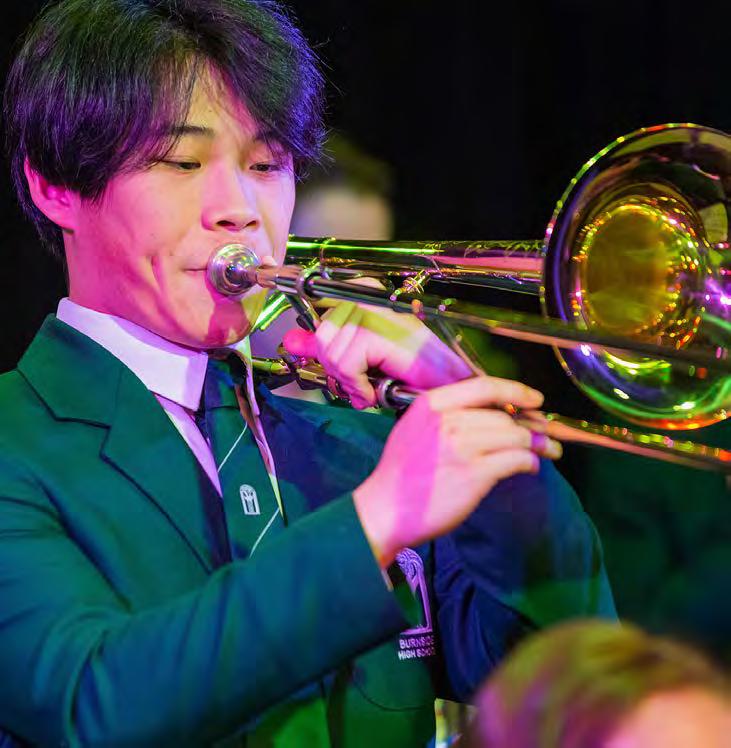
improvisation workshops with Hamish Smith and a conducting masterclass with Vincent Hardaker.
• Music as a compulsory curriculum subject through junior years and NCEA. We provide an all-encompassing academic programme that we see as fundamental in supporting performance work, starting in Year 9 with a particular focus on Theory and Aural alongside Music History and Composition. Currently, NCEA studies allow for further specialism with innovative new courses available in Music Technology, Conducting and Contemporary Music.
• Co-curricular ensemble rehearsals and performances.


• SMP Pianists and Vocalists are encouraged to begin learning an orchestral/band instrument from Year 9. The Specialist Music Programme is for the most talented of young musicians who wish to make Music their priority for the whole of their high school years and have the drive, commitment, and wider support network to sustain a five-year-long drive for excellence. To put this in context, there are around 600 students involved in Music in some way at Burnside, either taking music courses, having ITM lessons or playing and singing in co-curricular
CHRIS PETCH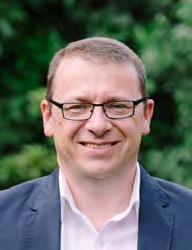
ensembles; SMP students therefore represent around 15% of this number. We are fortunate to have a full Symphony Orchestra, Symphonic Wind Band, Big Band, Funk Band, Contemporary Band, and a range of choirs, all of whom achieve consistently high results on the concert and competition stage, as well as a uniquely designed Junior Music Programme where the foundations are laid.
Much of this success is due to the relentless drive and dedication of the Burnside Music Department team of staff. It has always been our guiding principle at Burnside that Music be delivered by highly specialist teachers who are allowed to teach within their specialist area; we are fortunate that our student numbers and therefore staffing hours are higher than most schools which enables us to do this. The world is littered with SMP graduates who are forging successful musical careers, both here in New Zealand and overseas, as well as those who pursued alternative career paths but recognise the extraordinary value that being a member of SMP at Burnside High School added to their secondary education. SMP is a true gem of a programme that will undoubtedly continue to go from strength to strength.
I’m writing this in August and I’m sitting at a desk at school – not the most exciting introduction, however, this would have been extraordinary last year. This time last year, I was at home and starting my second week of lockdown, a lockdown that would eventually last 100 days. Even when it finished, the flow-on-effect was considerable, and the classrooms we returned to had changed.
Staples of music education such as Wind Instruments were banned, or at best confined to outdoors, and itinerant teachers could not teach across multiple schools. Students were allowed back, but many were hesitant or had other barriers preventing this from happening. It has been a time of significant change and, therefore, a reasonable time to reflect. One of my lockdown online success stories came from the game Gimkit (gimkit.com). Gimkit is similar to other online gaming platforms like Kahoot in that the teacher accesses (or creates) a kit of questions. Where it differs is that the students answer the questions at their own pace, with questions appearing on their individual screens and the teacher's screen projecting the scores. Where this game excels (in my opinion) is gamifying rote learning (yes, I’m well aware of memorisation being such a lowly peg on most learning taxonomies, but it’s still such a useful way of building a strong basic understanding). Gimkit rewards correct
answers with in-game dollars, which can then be used to purchase ‘upgrades’ (increasing your ability to earn money faster) or ‘powerups’ (different functions including the ability to punish or support others). In short, it was made by a student to make learning more fun for students. As the creator says on the website:
Games really helped me become engaged in school. That's why I built Gimkit — to be the kind of game I'd want to play in class.”
The full version of Gimkit is subscription based, but they have recently released a free version that incorporates most if not all the features I tend to use. It incorporates a concept called ‘Smart Repetition’ where an incorrect response triggers an increase of that question being asked.

Most of all, I find my students really enjoy this concept of learning. I play along with them, and while some students want to simply win, others are keen to spend their dollars punishing me as much as possible.
The gamification of learning may not be to everyone’s tastes, but during those long lockdown lesson days, it certainly helped increase engagement from my ākonga and provided a welcome change from Kahoot. Gimkit is less well known than other programmes so the risk of overuse and over -itness is lessened.
Now that we are back in classes and edging ever closer to being back to normal, I realise how much I enjoy having real-world contexts as a basis for assessment and authentic learning. The likes of Smokefree Rockquest and Tangata Beats or the Lion Foundation Songwriting competition provide this, and I am certainly hopeful, if not a little anxious, that we will be able to continue this with the new standards currently being written.
So much of what we do as music educators is that blurred line of education occurring outside the constraints of a normal classroom – and is also what makes our subject area so exciting for our learners.
BIO: Tim Randle is a proud Otautahi man, currently in Auckland where he has been squatting for some time. Head of Music at Manurewa High School, Tim’s passions are (in no particular order) bass –single and double, malt whiskey – single, Arsenal, the Crusaders, the All Blacks, the Black Caps and his kittens, kids and wife.

“Hey, I'm Josh! I started Gimkit as a high school project."
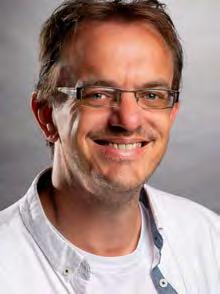
Recently I listened to mega-popstar Beyoncé’s latest studio album Renaissance, a collection of well-crafted pop bangers featuring a vast litany of musical offerings from some of the hottest songwriters and producers on the planet. Indeed, a quick look through the album credits on allmusic.com reveals more than 100 people are credited as either composer or producer on the 16-song album, a testament to the importance of collaboration in today’s music industry. As astonishing as this is, it’s not the first time this type of model has been applied to music making. In fact, this ‘assembly line’ approach, where specialized composers, producers, arrangers, and lyricists provide the repertoire for a performing artist, was the norm during the Brill Building and Motown boom of the 1960s and lasted until the rise of the singer-songwriter era which emphasised artists who wrote all of their own music.
delivering the music of expert composers with little to no consideration of the true nature of the personalities behind the music. Historically speaking, our expectations of popular music artists to be ‘authentic’ comes and goes in waves.
At the heart of this discourse is the issue of authenticity. Authenticity is the notion that an artist is writing from a place of personal expression, that the views expressed directly in the lyrics (and semiotically in videos, album artwork, fashion etc.) are a direct reflection of the artist, about how they see the world and what they have to say. Of course, the more composers and producers that have their fingers in the proverbial creative pie the harder it becomes to argue that authenticity is at the core of the artistic experience. This is, however, not a fatal flaw in music making. Sometimes audiences themselves do not place much emphasis on authenticity and are satisfied listening to expert performers
To bring this back to the title of the essay then, what do we teach our future songwriters? Based on the emphasis of craftsmanship in popular music today, the direction for educating our current students seems clear. But what of tomorrow? History tells us that the importance of craftsmanship and music-making based on tried and tested models of creativity will eventually give way to something else. As educators, if our goal is not to produce songwriters and producers who are expertly trained in successful models of music making, where then should our efforts lie? If craftsmanship lies at one end of the creative spectrum, at the other is the notion of artistry. Unlike craftsmanship which embraces tried and tested models of music making, artistry embraces the experimental and the unknown… the uncharted course where the outcome is uncertain. This approach encourages, in fact requires, risk-taking… the act of committing to a course of action unsure of what the outcome will be. Failure is a natural part of this experience. Perhaps then our goal should be to produce artists who will accept failure as part of the process and learn to embrace their own sense of identity, whether that be as master craftspeople or experimental artists. Regardless of the direction our students choose for themselves, one of the biggest hurdles they will most likely need our help with is fear. Fear of failure. Fear of being judged. Fear of not being good enough. Fear is that inner demon that nearly all artists wrestle with, not just the fear of rejection from an audience, but also fear that the finished work won’t be any good. This is one of the reasons that so many people start but never finish pieces of art, for so long as it remains unfinished it can never be seen as a ‘failure’, rather it is always a ‘work in progress’. Regardless of our students’ musical directions, we can teach them that that fear is not the enemy, but rather it is our compass. Fear tells us what we care most deeply about, it tells us what we are truly excited about. Fear shows us the direction towards that thing we want the most, and then stubbornly stands in our way. So, what do we teach our future songwriters? Yes, we teach them craft, and yes we teach them artistic exploration, but we also teach them about fear. We teach them not to run away from fear, but to run toward it. We teach them to do this every day. We teach them that the battle with fear must be fought whether one is a master craftsperson or an experimental artist, and that the best way to overcome fear is to show up, every day, and just do the thing without judgement. We teach them that if they do this every day, eventually fear steps to the side.
" Regardless of our students’ musical directions, we can teach them that that fear is not the enemy, but rather it is our compass. Fear tells us what we care most deeply about, it tells us what we are truly excited about."

Online learning resource for the music classroom. Teaching music theory and aural training through lessons, quizzes and games.
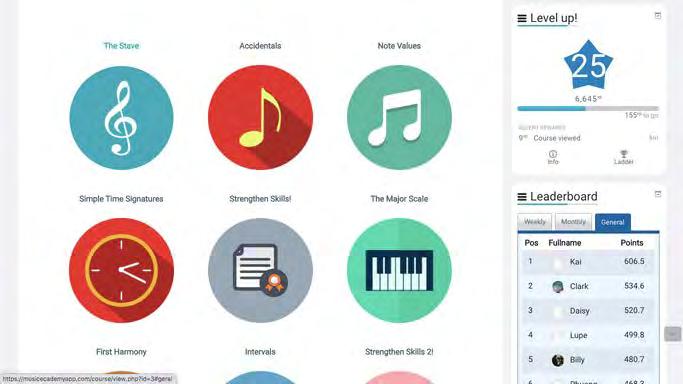

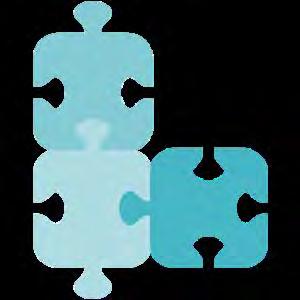

engaged. help your
Leaderboards, levels and badges help to keep students engaged. Thousands of possible questions in hundreds of quizzes help your students learn the best way possible – through practice!

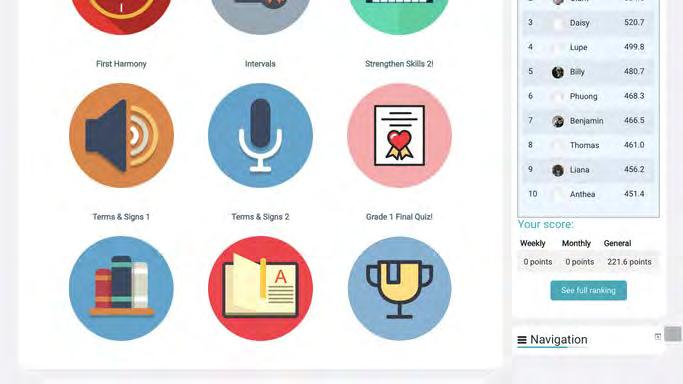


Developed in Aotearoa New Zealand. Curriculum following the major music exam boards, school curriculum including NCEA and musical terms in Te Reo Māori.

Teacher accounts allow you to track your students' progress. With individual logins for each student, Music Ecademy is perfect for BYOD.
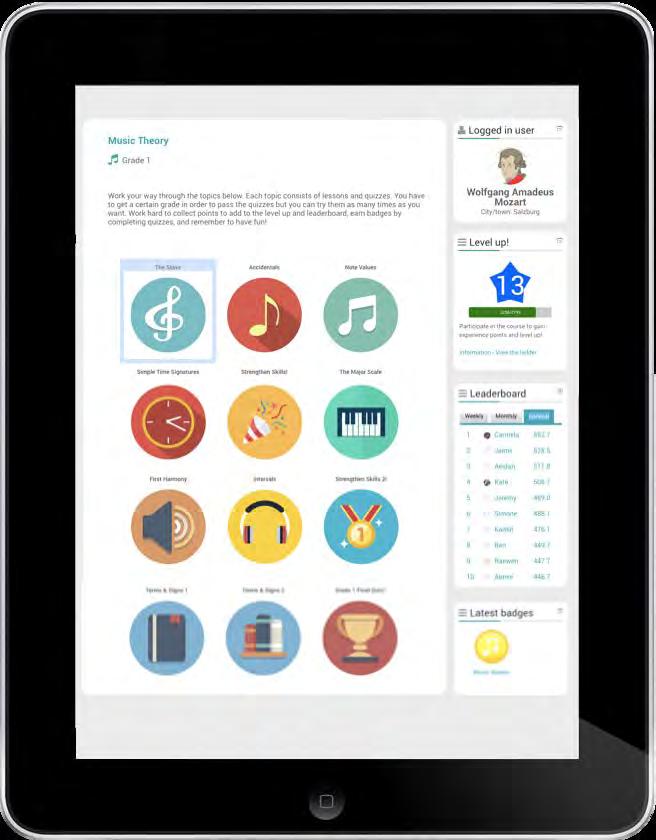

In my first article for the ‘Tune Me In’ magazine series, I felt it was only right to not only share the story and kaupapa of my platform 'Beat Whānau,' but also the ever -growing testimony of Rep FM’s ‘Passion To Profession’ – an educational initiative that I am now very proud to be a part of. The connection between 'Beat Whānau' and Rep FM comes through a collective appreciation for the people and places that have shaped New Zealand hip-hop and dance music over the years. Growing up with DJing and music production in Palmerston North, I started hanging out with the Noble Music Group amongst many other music lovers in my local community. Being connected to my fellow music peers on Facebook had lead me to discover a diverse range of NZ music blogs such as ‘AYEBRO’ and ‘Bassment’. By the time I had reached senior school, I was exposed to a great network of our nation’s musical talent. A Facebook page by the name ‘RepFM’ came onto my radar back in my final years at school, but it wasn’t till I reached tertiary that I truly saw the scale of their operation, with their kaupapa including their annual music-producer competition titled ‘Rep Your Beats’ along with their undeniably successful vocational-education programme, ‘Passion To Profession’. Since both initiatives had been running annually since around 2015, as the years went by, I became more ‘in-tune’ with the local and national mahi that Rep FM was involved in.
Fast-forwarding the journey to 2020, I began hosting a series of recorded Zoom calls, capturing the background stories behind some of my close friends in the music industry. I had initially signed up for a Pro membership on Zoom during the first lockdown, with a plan of hosting some interactive music production sessions. Due to the fact I was running a ‘hackintosh’, I faced some issues with Zoom’s audio-capture drivers. Whilst I initially felt a bit discouraged with the situation, I soon realised that I could beat the odds by utilising the Zoom platform to kick off my idea for a music-podcast series. By the time our lockdown alert levels had lowered, I had recorded around twenty episodes. Coming up with the name ‘Beat Whānau’ came from pure instinct, especially since this was a name I used to address all my ‘music family’ on Facebook.
Jumping ahead to 2021, I saw the ‘Passion To Profession’ programme reappear on my Facebook feed and took it upon myself to apply. As I went ahead to apply, I also knew I had a lot to offer as a tutor with almost a decade of experience in electronic music and digital solutions. What blew me away was the fact that whilst I had initially planted the seeds to be part of Passion To Profession, a fellow music friend and colleague, Daniel Love (DLove), was also in the process of planting these same seeds for both of us. Toko, Daniel and I had found ourselves together at the South Auckland edition of the 2022 Aotearoa Music Producer Series, and as they say, the rest is history. During the last few weeks of preparation for this year’s Passion To Profession programme, we have managed to get our domain and website live (p2p.school. nz) along with a few promotional videos across our online platforms. Our classes will be kicking off in early October 2022 and will be based in Manukau Central, South Auckland. All the courses we have planned for Term 4 will be free and are open to both youth and young adults. This year, we will be covering courses in music & audio engineering, clothing & merch design, Māori carving & visual arts, and also business & self-entrepreneurship. Through collective networks amongst our respective creative industries, we’ve also secured some awesome industry professionals and itinerant mentors. 'Beat Whānau' now has well over seventy episodes online, covering a range of music artists, taste-makers and professionals in NZ music. Since I had rediscovered my childhood dream of becoming a school teacher, I knew that pushing the advancements of modern music technology was something I was deeply passionate about. Today, I see the future of 'Beat Whānau' heading towards a platform for positive societal impact through the growth of digital music & sound opportunities here in Aotearoa. With Rep FM covering a great archive of hip-hop music culture and 'Beat Whānau' covering pop and dance music culture, I am excited to see how our collaborations will continue to unfold as the years progress.
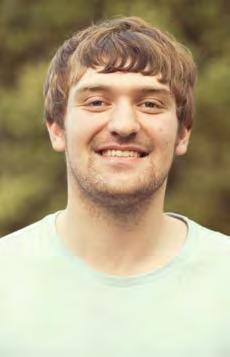
BIO: Samir Loumachi is an emerging music-tech educator, born in Auckland and raised in Palmerston North. His introduction to music came through a background of DJing and electronic music production. Since intermediate school, he has been fortunate enough to engage as a student, teacher, and leader in a diverse range of roles, positions, certificates and professional development programmes over his decade -long journey in music, technology and education.
To close off this article, I would like to make a special mention to Delysse and Duncan for linking me up here in the MENZA community. And also, a few quick shoutouts. Firstly, to Kiran and the team at MoveSpace for providing a safe and secure workspace to help me get through my studies and projects. Secondly, to all my classmates, lecturers and staff that I met at AUT. Lastly, a big thank you to each member here in the MENZA community. I am looking forward to Aotearoa’s bright future in the digital world. Also, please feel free to spread the word on ‘Passion To Profession’ with your friends and whānau, especially if you know a current school student or recent school-leaver who may benefit from participating in our course. More information on ‘Passion To Profession’ can be found on our website - p2p.school.nz
The effective integration of technology into your music program can provide huge benefits in student engagement and learning outcomes. But successful integration requires careful planning and a solid understanding of • current best practice
years in Australia and 6 years in NZ, with industry experience spanning more than 45 years.
In that time we have designed, installed and commissioned hundreds of music and digital media labs and a huge range of music, audio, video and lighting technology in schools across the region. This includes multi-million dollar performing arts building projects.

Let us help you plan and build a successful future with technology.
• Music & Media Software
• Computer Music Hardware
• budgets and funding options
• professional development needs
Music EDnet has been working with teachers, ICT staff and decision makers at all levels of education for 31
• Audio Recording
• Live Sound & PA
• Instruments
• Video Recording & Streaming
• Lighting
• Training & Support
• Facility Design & installation
Kia ora koutou. Haere mai to the NCEA and External Moderation Update.
Amongst the terrible weather events and surging Covid-19 cases over winter, it is gratifying that we have been able to celebrate the return of in-person secondary school music events and competitions. How exciting to see the Big Sing Finale featuring in recent TV news items, and to have been able to attend the finals of the NZCT Chamber Music Competition in Tāmaki Makaurau. Other competitions such as the KBB Music Festival, Southern Jam Jazz Festival, SFRQ, Tangata Beats can all go ahead without fear of cancellations. School calendars can include productions again and classes are back in classrooms.
I hope assessment is as normal and successful as possible for you and your ākonga for the rest of the year.
Trialling the standards allows the Ministry of Education and NZQA to better understand how the draft standards and assessment materials work in a classroom setting.
Remember that this year the piloting process is on a small scale, and it will not be until the end of 2023 that the standards and wrap-around support materials will be fully fit for purpose.
It is very much a case of ‘watch this space’ and keep doing what you’re already doing, providing engaging and ākonga focused programmes.
Over the last couple of months digital submissions have been proving more difficult to access. Please do not forget to make your permission settings for Google Drive links set to “anyone with the link can view.”
These can be accessed using your Education Sector Logon on our Pūtake website.
The NCEA Review of Achievement Standards (RAS) for Music has seen the mini-pilot schools complete 1.1 (internal, music concepts), 1.2 (external, music contexts) during the first half of the year. They are currently working towards completing 1.2 (internal, performance) and 1.3 (external, composition).
The new Making Assessor Judgements course for 91425 Level 3 Research is now live for teachers to enrol in.
There is also a free short course for all teachers focused on ‘Culturally Responsive Assessment’. Visit nzqa.govt.nz/online-support to learn more.
Hei kōnā mai Delysse Glynn NAMBIO: Delysse Glynn, National Assessment Moderator for NCEA Music. I’ve been in the role for 10 years and over that time have led a very consistent team of contractors, who like you, are secondary school music teachers. Recently, the team increased from 5 to 13. This is to prepare for the increased workload that RAS will create. It is a privilege to work alongside these highly experienced teachers and hear first-hand the peaks and troughs of music teaching. As a community-minded individual I’m involved in the Auckland Bagpipe band scene as a drummer in the City of Auckland Pipe Band and perform regularly with a wonderful group of musicians at the Cathedral of St Patrick and St Joseph, Auckland. Like all community music groups, we’ve struggled through Covid-19 restrictions and mandates. It’s made me realise how important these groups are for my mental, physical, and social well-being. At least my other hobby, learning Italian, could be held on Zoom!

“ I hope assessment is as normal and successful as possible for you and your ākonga for the rest of the year."

With the NCEA change imminently upon us there has been a growing realisation among secondary teachers that at some stage soon, we won't be able to delay the inevitable any longer… Soon we will have to ‘face the music’ and implement the new Level 1 program (pun intended).
Although still a work in progress, the reviewed NCEA platform represents some of the biggest changes to secondary education in a generation. Any teacher who has sat down with students and parents during the course selection process will understand that the current NCEA structure has snowballed into a complex cocktail of mindaltering ingredients: numeracy, literacy (don’t forget the reading/writing credits for UE!), gather 80 credits, carry 20 into the following year, and then again into the year after that… Perhaps we should be giving students credits if they can pass a test on understanding NCEA?!

NCEA Music has also become inequitable, with only the students who have highly developed aural, score reading and essay writing skills being allowed to stand on the hallowed ground of Merit and Excellence endorsements. Prince, Elvis, Madonna and Michael Jackson would probably all have failed to endorse in Music under the current NCEA system. Remember that time you transcribed that piece of music without your instrument at hand? No, me neither. Without diminishing the importance of theory and aural skills to a well-rounded musician, a large hall with evenly spaced desks isn't exactly the most conducive way to proving one's level of musicianship. Thankfully, the team behind the changes
in Music have addressed many of these issues and the new Level 1 Music program is looking far more equitable for performers and composers.
To give us space and time to work through the NCEA change programme, the MoE provided us with some teacher-only days. On these days, teachers could digest the refined ‘products’ that are now available. The Canterbury Ministry of Education office, alongside the Canterbury West Coast Principals’ Association, listened to feedback from teachers and principals and developed our recent August Accord Day into a Collaboration Day. Eight venues hosted the different curriculum areas across Christchurch. The MoE then reached out to the local subject associations to lead the day. Having just taken over as Chair of the CWSMTA (Canterbury Westland Music Teachers Association) the responsibility for organising the program for Music fell to me. Eek.
With no prescribed outline for the day, we were allowed to use the time as we saw fit. Creative Arts was hosted at Shirley Boys’ High School, and we decided to break the day into three sessions, with the first session being a joint plenary meeting with all 350 or so creative arts teachers in the Large Theatre at Ōrua Paeroa (the Shirley Boys High/Avonside Girls High campus). Shirley Boys’ twin duo, Te Akaraupou and Tanemahuta Pakeha-Heke performed and spoke on their kaupapa around family violence, and the powerful role that music and the arts play in their education. These boys were recently on Seven Sharp and their own experience with family violence has helped lift a challenging topic to the fore, with
their ability to deliver tough messages through song. I am sure we will hear more from these extremely talented boys in the years to come.
Jennie Williams, the national Arts Learning Area Lead, then spoke on the wider updates of where the NCEA change is at, with an Arts focus. A huge thanks to Jennie for making the time to come down and speak to us in person, as well as her assistance in planning the day alongside us.
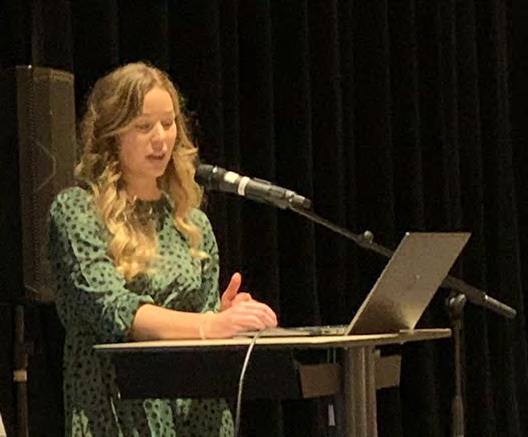

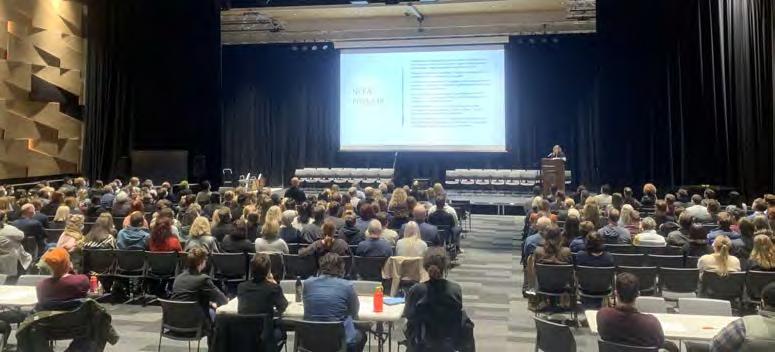
For the second session we broke into our learning area groups. There were around 80 attending in Music - the largest gathering of secondary music teachers in Christchurch in a very long time. Jane Herman (Papanui High School), Regan Barker (Christchurch Boys’ High School), Miranda Scott (Marian College) and Ben Crosson (St Thomas of Canterbury College) delivered excellent presentations on each of the four achievement standards in the Level 1 Music curriculum. It was a great way to get a deeper understanding of what is involved in each of the standards, and the connections to some of the ‘Big Ideas’ that underpin them.
We were given the opportunity to do a Q&A with two schools who are currently piloting the new L1 course - David Sims from Ruapehu College and Liam Boyle from Wellington College. Before the day, I reached out to the CWSMTA members and asked them for their questions to present to these two pilot schools. These questions were then asked in an interview with David and Liam who offered some excellent insights into how the pilot is going
BIO: Brad Banks is a musician and music educator in Canterbury. Since graduating from Ara Music Arts in 2001 with a Bachelor of Music (Composition/Arranging), he has performed throughout New Zealand and internationally in numerous groups including Dukes and Nomad. He completed a Graduate Diploma of Teaching and Learning in 2002 and then went on to work in a variety of roles in schools across Ōtautahi. Since 2015, Brad has worked at Shirley Boys’ High School where he is Head of Faculty for Performing Arts.

from both a decile 2 and decile 10 perspective. Although only midway through the year and with only two of the four standards completed, the feedback so far has been very positive. The standards will be refined again based on feedback before a full pilot of around 15 schools gets underway in 2023.
We then broke into groups, brainstorming what Level 2 Music could look like. With two strands in Level 2 currently titled Making Music and Music Studies, there is the space to make a flexible and engaging music course that will suit a variety of kura and ākonga strengths. With feedback from kaiako and the Subject Expert Group, it is exciting to see how these two strands will come together.
The final session was a live conference update with Matt Stenbo, the Lead Advisor for Music. Matt delivered a general update before answering pre-prepared questions from the CWSMTA. Matt was able to settle many of the issues and concerns that had been raised throughout the day and it was a great way to finish a busy but productive event. As always, a huge highlight was catching up with colleagues from across Ōtautahi and beyond - we are very fortunate to have such an excellent community of music educators.
A huge thanks to Jennie Williams, Matt Stenbo, David Sims, Liam Boyle, Joseph Houghton (CHCH MoE) and of course the CWSMTA members for the huge mahi that went into making the day possible.
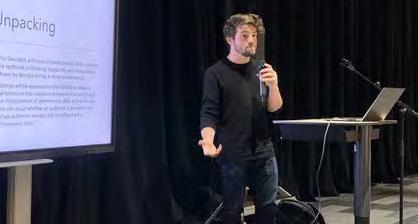

In order for accelerated pedagogy to take place, it requires the ‘system’ to function as a genuine collaborative learning whānau - learning, nurturing and growing together. When we use the word ‘system’, we often refer to the one-hour lessons in the classroom, moving from one subject to another, not by your choice but because you’re only allowed an hour or sometimes two. We are often restricted by timetables, and decisions made by the top table; the ‘system’ is focused on data and genuinely not about the story behind the data. Let's revisit the six elements of Te Kotahitanga and its ‘Effective Teaching Profile’, its effectiveness in raising student pedagogy and achievement - and its relationship to our Toi Māori Wānanga.
1. MANAAKITANGA – teachers care for their students as culturally located human beings above all else. Mana-aki-tanga - to develop, support and enhance the mana of all students. In order to develop, support or enhance the mana of our students, we first have to understand a.) what mana is, then b.) what mana our students hold, c.) what condition this mana is in, and d.) how do we connect, or





what connection can we make with the student. This will enable genuine relationships, which will allow the students to be open to sharing whakaaro, share whakapapa and ultimately be open to new learning. This can be accomplished by whakawhanaungatanga, however, it takes a professional to read the room and know what taakaro to engage in.
2. MANA MOTUHAKE – teachers care for the performance of their students.

As the wānanga progresses, you will see when breaks are needed and gauge the students' energy levels. Repetitive tasks to regurgitate knowledge are best for retention and allow the students to practise in different spaces using different activities to mix things up, whether we were in the marae in the ngahere, or on the beach after a game of Ki-o-rahi, it was targeted questioning and taakaro to trigger the mind to regurgitate the pūrākau. Our rangatahi are our partners in learning, it is a two-way relationship between kaiako and akonga.

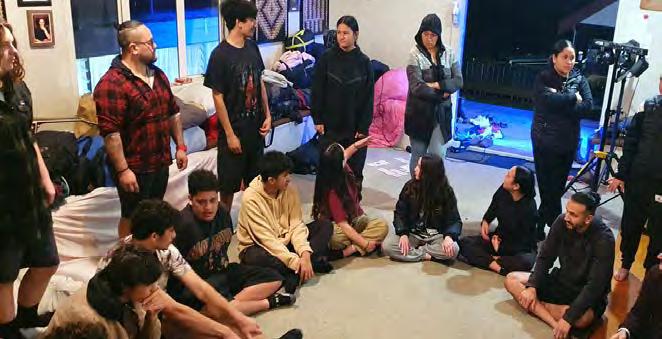
“I loved it!”
JACOB RAUI-MUNU
"It was easier to learn at wananga than at school because you are forced to listen- or you sound dumb when you have to korero"
“At our next wananga I want to practice more on the taonga so I get more confident. ”
LAWE RIWHI-MOIHI
Ko te piko te māhuri, Koia te tipu o te rākau. He rito tangata, he mauri reo, he mauri oro, he mauri ora.
3. NGA WHAKAPIRINGATANGA – teachers are able to create a secure, well-managed learning environment.
Six P’s talk about Proper Preparation Prevents Piss Poor Performance. If it isn’t set up well or is managed poorly, students will either go two ways - out the gate or become disrespectful and find the kaupapa of no value. Piringa, which is to connect, to link to create seamless joins, also talks about the value of relationships and, again, the importance of whakawhanaungatanga.
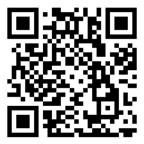

4. WANANGA – teachers are able to engage in effective teaching interactions with Māori students as Māori. This is not only effective for Māori & Māori relationships but also for other cultures and the meaningfulness around feeling safe and encouraged, that making mistakes is a good thing and having the quality time to reflect as a class group, small groups or one on one. The importance of whanaunga through the wānanga and throughout the kaupapa is vital to maintain energy levels and safe working spaces and relationships.
5. AKO – teachers can use strategies that promote effective teaching interactions and relationships with their learners.
During wānanga you will use most if not all of the tools in your kete, but more importantly you will learn more strategies, taakaro, activities during the wānanga from both kaiako and akonga. Wānanga is a genuine space for all to learn, ma te tuakana te teina, ma te teina to tuakana.

6. KOTAHITANGA – teachers promote, monitor and reflect on outcomes that in turn lead to improvements in educational achievement for Māori students. Creating a sense of unity, solidarity and collective/holistic learning outcomes.
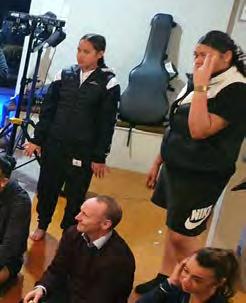
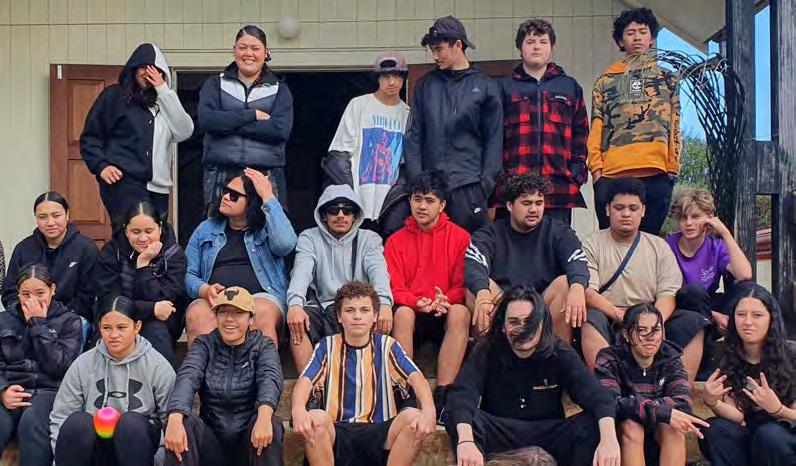





Creating a space where students can be themselves and learn, create and share when, where and how they want to. All of this is within a co-constructed framework established with facilitators, kaimahi, kaiako, students and whānau. All are stakeholders in the wānanga process.

“I enjoyed listening to all the stories of our Taonga.”
“At the next wananga I want to gain more confidence in the performance side of Taonga Puoro.”
JONTAY HENRY
“Probably learning about the different instruments, their traditional uses and stories.”
A flounder will never return to the spot in which it has moved from Once you miss the flounder you rarely have another chance to capture it again This talks about the opportunities our students get as they may not come back around, so do your best and savour the moments
The genesis of the Whakaaro Tahi Community Trust’s music programme emerged from my day-to-day experience working as a secondary school teacher at Whangaroa College in Kaeo, a low-decile secondary school in the far North. IMAGE 1.






While there I noticed that disengaged rangatahi (youth) were seriously lacking extra-curricular activities that could engage and encourage them to succeed and enjoy learning on their own terms, and somehow integrate that learning with their school education. The College already had musically gifted students such as Shaun and Jimmy Colbert (from the now internationally renowned ‘1814’ band) But many of their peers had no formal pathway to advance their passion. Apart from anything else, the college lacked even a rudimentary Music Department.
As Whangaroa Tahi Community Music, I wrote applications and raised funds to buy equipment. Initially, in 2005, we were able to launch the programme with music sessions held in the

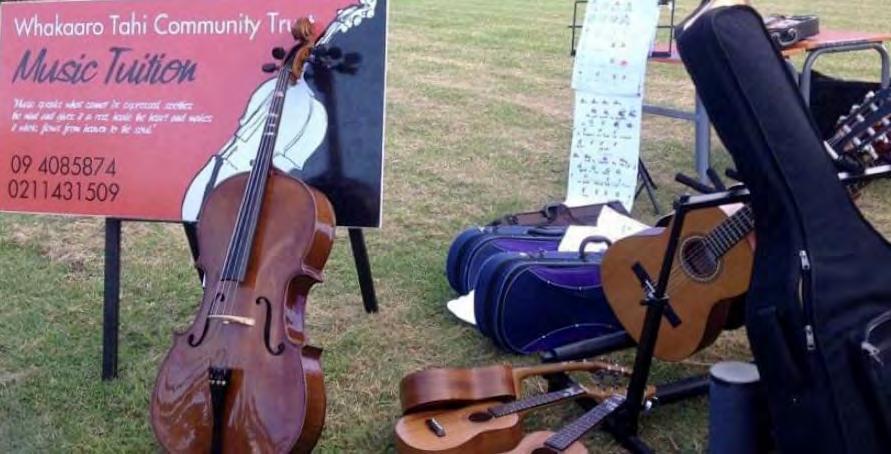
Social Sciences resource room at lunch-times, in any spare periods, or after school. Eventually I had enough funding to hire our first paid tutors - Bundy Waitai and Mohi Te Hana Dawson - who worked out of a suite of rooms at Whangaroa College. The Trust’s other tutors have since included Denise Stothard, Kawiti Juventin, Peter Welby, John Hailstone, Simon Whitehead, Damien Rice, Emma Paki, Sherry Pomare, Christoph Maubach, Eli Moore, Brady Arkle, Jen Whittington, Jade Leatherby-Tipene from the band Paua and long-standing tutors like Jane Hillier and Tups Ellis – and this is by no means a complete list. About four years after our initial launch, the Trust in its present form was established, and our music programmes became available to the wider Far North community, including home school students. We have travelled and have delivered tuition to areas such as Mitimiti, Pawarenga, Panguru, Broadwood, Kaitaia, Oturu, Pamapuria, Paparore, Kaingaroa, Taipa, Peria, Mangonui, Oruiati, Waitaruke and Whangaroa. We even conducted a music programme in Ngawha Prison for a time.

“Music speaks what cannot be expressed, soothes the mind and gives it rest; heals the heart and makes it whole, flows from heaven to the soul.”2. WAITARUKE STUDENTS PERFORMING AT THE ANNUAL WAITARUKE CULTURAL FESTIVAL 1. WHAKAARO TAHI COMMUNITY TRUST’S MUSIC PROGRAMME 3. GROUP OF TRUST STUDENTS CELEBRATING NZ MUSIC MONTH AND STUDENTS IN PINK SUPPORTING ANTI BULLYING DAY
Present tutors are now currently teaching some of my original pupils’ children.


Our whole kaupapa (purpose) is to empower rangatahi with musical interests to achieve their goals and dreams by eliminating as much as possible barriers such as equipment availability, isolation, tuition fees, and the like. Hopefully, with our support and guidance, they can transition their passion and joy of music into a lifelong journey of unique self-development and cultural expression.
IMAGE 2. It’s a given that in a host of ways music enriches our lives and promotes connection with others, and so needs to be available to all. The universal language of music is a tailor-made way to bring our diverse Te Tai Tokerau communities together.
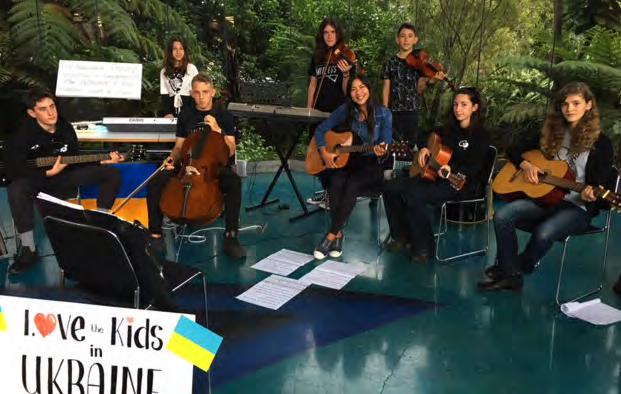
Countless studies abound listing the cognitive and social benefits of music – enhanced brain development, concentration, self confidence, empathy, listening skills, creativity, literacy and maths benefits, how it reduces stress, increases well being (especially at this time), cooperation, trust, respect and community connections, and so on and so forth.
But the key element underpinning Whakaaro Tahi Community Trust’s kaupapa is simply “engagement”. Music is the key that unlocks many previously uncharted domains, because






– even for those who don’t aspire to be professional musicians – it opens doors to all manner of other opportunities and vocations, practical all-round life-skills, and new mentors and networks. And also simply because it’s a perfect vehicle to self-express, and just great fun - especially when you’re part of a team.

While our initial programme enjoyed almost immediate success at Whangaroa College, the college’s original situation was by no means an isolated case. The Far North unfortunately is near the head of the field in many negative statistics, and sadly this also applies to availability of suitable and effective resources in many of its public schools compared to not only – most markedly - private schools, but also public schools in higher socio -economic areas.
The evidence from our own initial programmes showed the benefits to individuals and to the wider community to be very real, very positive, and – particularly in the context of the Far North’s particular needs – to be highly effective.
The Trust was therefore specifically established to address this inequity that makes music a luxury for the financially able. We strongly believe that music needs to be accessible to all students, and not just the privileged few. CONTINUED..
CONT... Whakaaro Tahi Community Trust has lived and breathed this philosophy since our inception.





The Trust has provided foundation music skills at early childhood centres (ORFF programme) and primary level, as well as facilitating students to attend music programmes at New Zealand universities and Music Schools such as MAINZ, and assisting numerous Far North students to achieve NCEA credits in music.
Our programmes have also included working with junior and senior bands and orchestral ensembles, and fostering skills in vocals, keyboards, guitar, uku, cello, violin, electric and double bass, saxophone and flute. We promote original songwriting and performance at community events, and have participated in many events such the Ukulele festival, Rock Quest, Big Sing, etc., and have enjoyed success in many of these events and songwriting competitions.

IMAGE 4. PG37 Our students have produced many original songs over the years, and these have included songs written specifically to raise funds for events such as ANZAC, the Christchurch earthquake and the Ukraine invasion. We have also been encouraging our more advanced students to enter music examinations through the Associated Board of the Royal Schools of Music, London. While Covid has hindered these activities in the past two years, hopefully November will see some of our students enjoying this wonderful global experience again.
IMAGE 3. PG36 Students have showcased their work at local and regional events, street performances, in the atrium at Te Ahu centre in Kaitaia, at local and cultural festivals; rest homes, Xmas festivals and end-of-year performances, and also perform an annual carols event in Mangonui. Our secondary student bands have done well in the past and now our home school group are building up their repertoire with jazz pieces including “Sway” and more challenging pieces like Paul Desmond/Brubeck’s “Take Five”; as well as writing and performing their own compositions. We hope to showcase these at the Mangonui Waterfront Festival in April next year, and then at the annual Jazz and Blues Festival in the Bay of Islands in August.
It’s not too hard to see how all these various endeavours and student accomplishment also help deliver many accompanying personal and social benefits such as building self-esteem, fostering teamwork and nurturing future career skills.
IMAGE 5. PG38 Whakaaro Tahi Community Trust takes pride in the fact that our programmes have played a crucial role in establishing a focal point for our youth and creating positive ripple-on effects through other sectors of Far North Rohe. Our continuing mission and kaupapa is to attract the wider community support to allow us to continue this journey - helping to stepping-stone many other present and future Far North rangatahi into achieving their own goals and fulfilling their own dreams while having fun and learning valuable life skills along the way.

“
Life without playing music is inconceivable for me. I live my daydreams in music. I see my life in terms of music, I get most joy in life out of music.”EINSTEIN5. PERIA STUDENTS PERFORMING IN TE AHU CENTRE FOR NZ MUSIC MONTH
January 21st and 22nd 2023
1-4pm each day
Christchurch
Don't miss this rare opportunity to study with Internationally-acclaimed music educator, Doug Goodkin!

Children are innately musical. If we learn to teach music musically we can cultivate, shape, nurture and develop their musicality for life.
Doug's workshops explore what makes a lesson feel musical so that process, product, performance and sense of community are fostered.
We will look at of how these musical activities can relate to all school subjects, in particular, integrating literacy and music.
Register at menza.co.nz

Cost: $50 single day $85 Early Bird before Dec 1st for both days!
School Music Teachers - has your practising certificate lapsed? Teacher
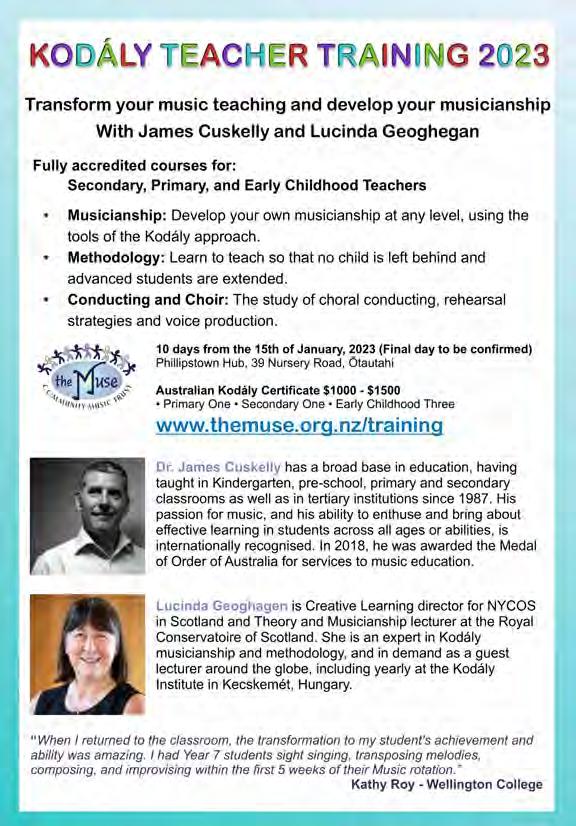


Take the IRMTNZ
TE R
Classical
Grades
Face-to-face | Digital
Students develop the skills that are specific to their instrument and authentic to the performer they want to be.
Discover wide-ranging repertoire lists, which now feature more female and international composers and contemporary works.
Personalise the exam — students can choose to perform their own, original composition, a duet at Initial to Grade 3 and a selection of supporting tests.
With face-to-face and digital options available, students can take their exam in the format that works best for them.
Find out more: trinitycollege.com/music
Explore the huge range of print and ebooks by Trinity College London Press.
trinitycollege.com/buy-music-books
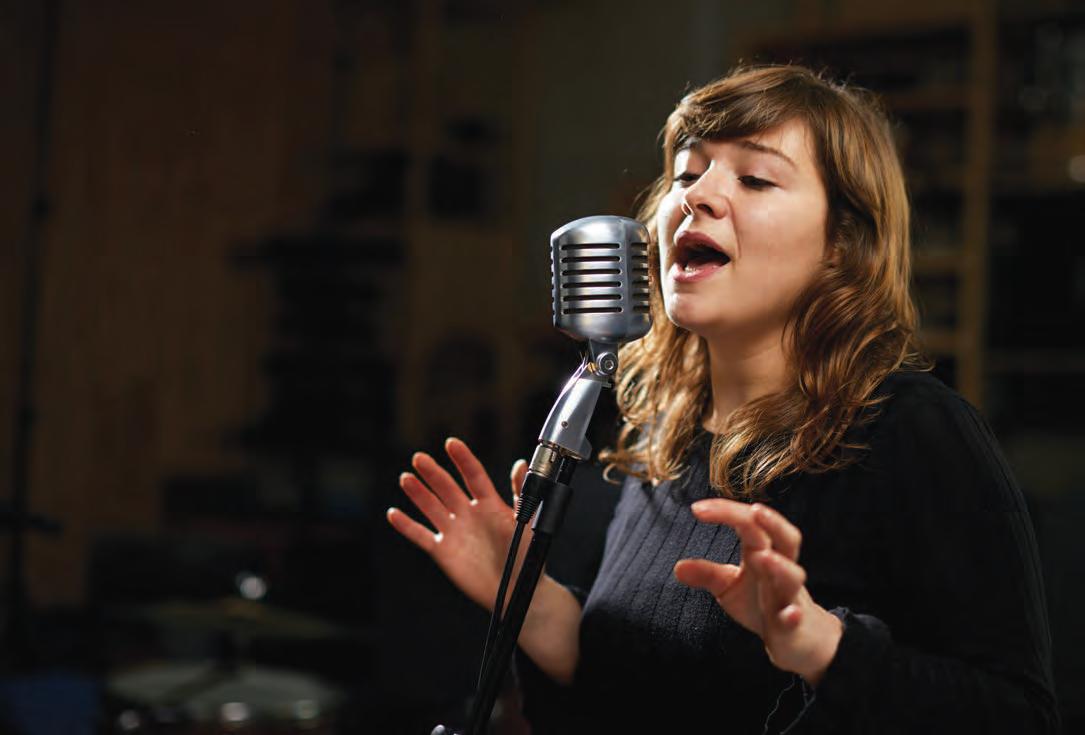
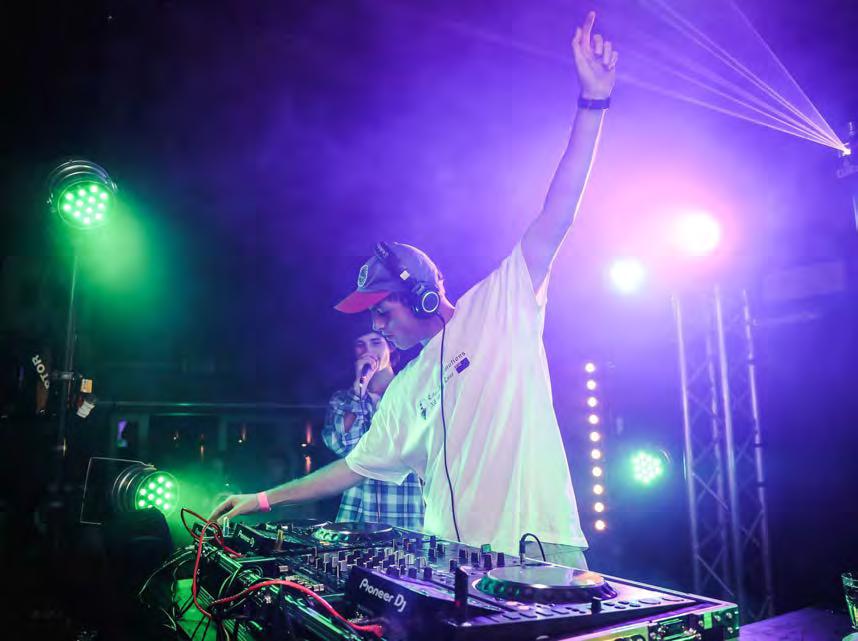
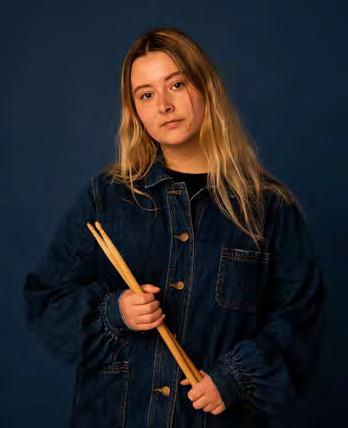
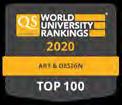
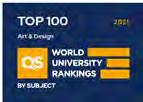

As society emerges from Covid restrictions and the world regains a sense of normality, we musicians are now getting those bookings again and able to share our music. As much as our work as music educators has endured the restrictions, it has been stressful. Planning events for students only to have them cancelled, being forced to run performance assessments in front of a camera and a handful of people (teaching in a mask no less) has been tough and yet for the belief in the value that learning an instrument and expressing creativity through music – we push on.
Likewise, my project, Te Hiku Music Academy, has been affected by the same setbacks and essentially, with everyone just holding on for the ride, the ability for people to give thought to moving in a different direction in employing a primary music specialist has been a hard sell. I became determined to devote my effort to finding and working with talented kids way earlier. I want to create the conditions for young talented musicians to excel and not just leave it to chance. In my opinion, as a primary trained teacher that has worked for a decent amount of time in Secondary, I found that many of our 13-year-olds are arriving at High school having not touched an instrument- unless they have grown up in circumstances where the parents have the means to invest in private music lessons or are musicians themselves.



During my time in Wellington studying music, I met Jonny Wilson, an entrepreneur and Jazz school alumni who, in 2010, had built a Music school in Lower Hutt with a client base of 2500 students and a large staff. His model was birthed out of building a group of 30 drum students and now they send Music buses to local Primary schools around the Wellington area. This inspired me to establish an academy in the Far North. On my return to the Far North, I worked in Kaitaia College and have had the opportunity to work at Kaitaia Primary one day per week. In April, I started my academy project at Pukenui School with the intention of starting at Oturu, Ngataki and Te Hapua in the coming weeks. Already, I have found a lot of enthusiasm from the students. It is a lovely change to arrive at my schools and be greeted and helped by my enthusiastic 9 and 10-year-olds. Music is a partnership, not competition…
I was recently reflecting on my time in Wellington with a new friend and described the ferociously competitive music environment there. This undoubtedly causes some to sink and brings out the best in others. At the heart of it is the desire to represent your art in the best way possible. The best musicians want to work with others at their level. It is understandable.
However, in returning to the Far North and facing the challenges I have described above, we don’t have the




luxury of picking and choosing who ‘makes the grade’. We have a shortage of teachers, and resources and distance are our enemy. Competition in our area only serves to fragment the tiny amount of momentum we have. And it is because of that belief that I sought to network with existing music programme providers who operate in the primary school space in the Far North. One such person who has been visionary yet quietly going about their trade is Sharyn Van Heerden, a local RTLB and music enthusiast. 17 years ago, she saw the same need as I do and established a charitable trust in the Far North named “Whakaaro Tahi” (think together). Her team is about five itinerants who teach a range of instruments from drums, bass and guitar to ukulele, cello, violin and flute in various schools in the Far North. We met together in 2021 and I wanted to glean as much as I could from her experience, and we both wanted to avoid competing for the same tutors, schools and same students. Already, Sharyn has shown support for my initiatives, for which I am grateful and has provided tuition and resourcing in different ways.
We are confident we can achieve more by supporting each other with our slightly different focuses. Still, there is much more work to do in working together across the Far North to communicate and strategise.
And we are only just getting started. In reality, Te Hiku Music Academy, despite receiving regular praise and






enthusiasm from people I talk to (Iwi representatives, Ministry representatives, fellow musicians, teachers and principals), it only consists of two people going into four schools.

I dream about having a mobile music facility (or even multiple facilities) that can solve the problem of distance by being equipped with all the appropriate equipment to deliver tuition in drums, guitar and keyboard to students across the Far North. It is my intention to establish it as a charitable trust in time, but in the meantime, we work as contractors and through staff funding.
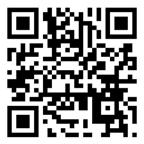
Eventually, I’d love to leverage my connection to the Wellington music schools and beyond to harvest some of the talent that emerges from there who would like to get into teaching. I think that there is a huge potential for us to attract young musicians who have done their paces by paying for the one-year course of study that is the Secondary Teaching Diploma in exchange for them teaching in the Far North for two years, much like the teachers of yesteryear being bonded to their schools.


All of these initiatives and ideas take time and, ultimately, risk. Music education is nothing new, but certainly, we need to be prepared to think more creatively and collectively if we want to see our young people maximise their talent.
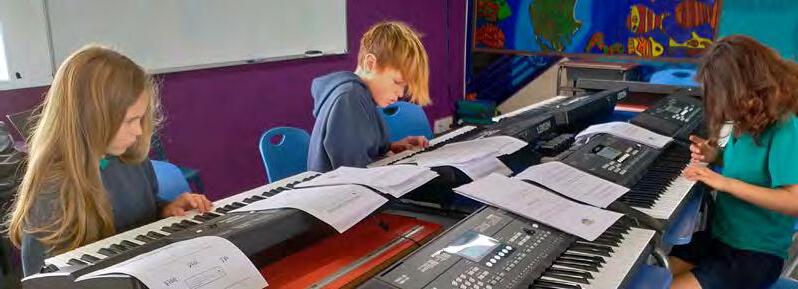

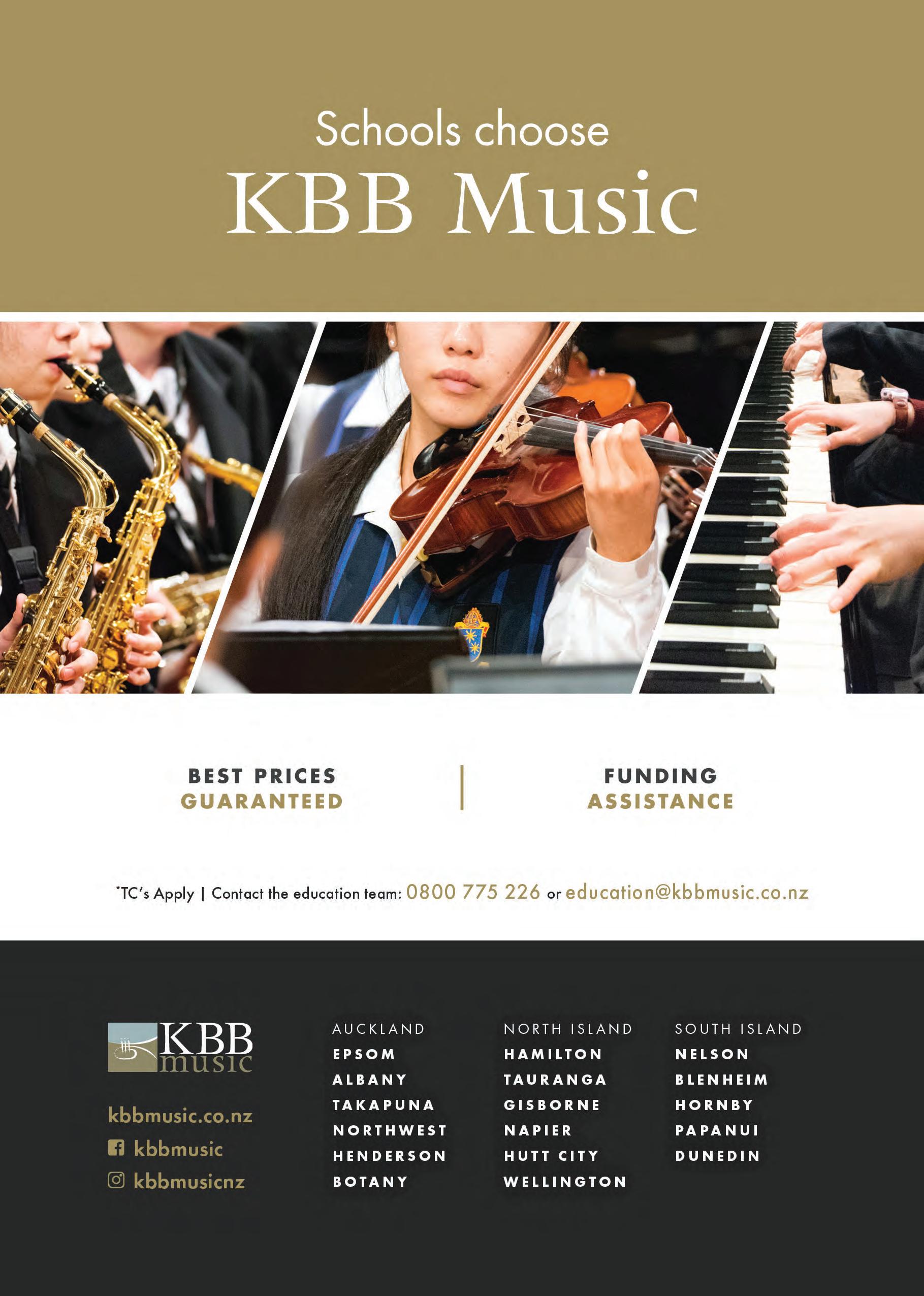
The Ministry for Pacific Peoples is the Crown’s principal advisor on policies and interventions aimed at improving outcomes for Pacific peoples in Aotearoa. Language Week celebrations had their origins in Samoa in 2007. In 2009, the Humans Rights Commission came on board and the concept of Pacific Language Weeks was born. Since 2010, the Ministry of Pacific Peoples has been supporting Pacific Language Weeks, promoting and raising awareness of the diversity of our Pacific Languages in Aotearoa.
In this article we will look at simple Pasifika phrases you can use in your classroom with your learners. Tongan language week is from September the 4th-10th of September, the



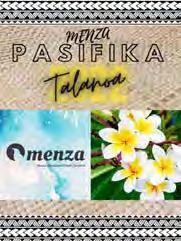
BIO: Anne-Marie Lalakai, TIC of Music at Wesley College, Paerata, Auckland. I am of Samoan and Tongan descent, I grew up in Dunedin and my passion for music was ignited by my high school music teacher. I have been a music teacher for 11 years, mostly working in South Auckland Schools. I am a double bassist and pianist by trade and thoroughly enjoy working in the classroom with young budding musicians.

theme for Tongan Language Week 2022 is: Ke Tu'uloa 'a e lea faka-Tonga' 'i Aotearoa, which means “Sustaining the Tongan Language in Aotearoa”.

We have our first lot of Musical Elements translated into Samoan, Tongan and Fijian. Thanks to Glenn Stanbridge for the original document, Sharon Ledua for the Fijian translation and Sola Vuna for the Tongan translation. Cook Islands Māori, Niuean and Tuvaluan are still in the process of translation and will come out in our next edition.
Mālo
Anne-Marie Lalakai
Mālō ‘aupito Thank you very much Fanau ako Students
Ko hai ho hingoa What is your name? Fanongo Listen
ā Goodbye Taimi ako Time to learn Fakamolemole Please Pō Ako Homework
Thank you Meitaki Vinaka vaka levu Fa’afetai
What is your name? Ko’ai tō’ou ingoa? O cei na yacamu? O ai lou igoa? Good bye ‘Aere rā Ni sa moce Tōfāv Please ‘Inē Kerekere Fa’amolemole
ENGLISH TONGAN FIJIAN SAMOAN
Timbre Anga ‘oe le’o/ongo Rogo ni sere Lanu
Rhythm Tā & Vā
Tainēmiki (Faka’ilonga
Dynamics
le’olahi moe le’osi’i)
Form Fa’unga
Veilutuki ni rorogo Taimi
Vadagu ni rorogo
Tuvatuva ni sere/dua na tiki ni vakatagi
Harmony Afo potupotu tatau Sota ni rorogo/domo
Melody Afo/Fasi
Tuvatuva ni rorogo
Leo tele ma le leo itiiti
Ituaiga o pese
Tufa’atasiga o leo
Fati
ANNE-MARIE LALAKAIAfter years of a nomadic existence, the Christchurch School of Music , Te Kura Puoro, (CSM) has been given the opportunity to build a $15 million facility in the city’s performing arts precinct..
As Music Director since 2012, this is an exciting and also terrifying prospect (think $15 million!). We will build a custom building that will include a large rehearsal and performance space, medium ensemble spaces, a well-equipped music classroom, a computer suite, 35 small and medium studios, offices, meeting room and a kitchen. The School currently has 1100 students aged from 6 months – 85 years and we offer tuition in a wide range of instruments, four symphony orchestras, two string orchestras, concert bands, wind ensembles, rock bands, jazz bands, chamber groups, recorder ensembles, pre-school groups, foundation classes and a samba band. Along with our out-of-hours programme, the CSM also offers an extensive outreach programme to local primary
schools, teaching strings, recorder, ukulele, percussion, band and orchestra.
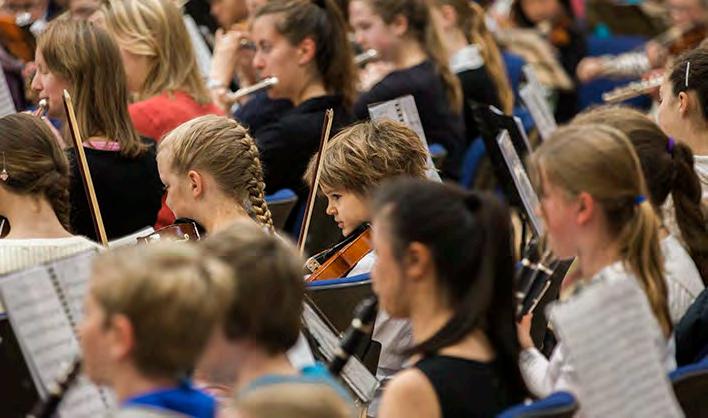
We lost our previous home when the earthquakes destroyed the Music Centre of Christchurch and since then (and prior to the Music Centre) CSM has leased space in multiple places including schools and warehouses. We currently operate from four portacoms for our office, library, classroom and storage in the central city and use Avonhead Primary School for our after -school and Saturday morning teaching and rehearsals.
CSM has always aimed to be a central city music school, accessible to students from all over the city and beyond and to have this opportunity is definitely a dream come true. The new building will be a community music education hub, available for hire to other groups and individuals in the city for teaching, rehearsals, workshops, seminars and recitals. Its proximity to our beautiful library, Tūranga, the new
After years of a nomadic existence, the Christchurch School of Music, Te Kura Puoro, (CSM) has been given the opportunity to build a $15 million facility in the city’s performing arts precinct.
BIO: Celia lives in Christchurch where she is Music Director of the Christchurch School of Music, Te Kura Puoro. She teaches flute, recorder and piano and runs foundation music classes for preschoolers and junior school students. She is co-director of a local children’s music festival, Strum, Strike and Blow and is a regular presenter of workshops in early childhood and primary music education throughout NZ. Celia is a past chair of MENZA, and vice-chair of Music Education Canterbury (MEC), is on the ONZA (Orff New Zealand Aotearoa) committee, secretary of the Christchurch Jazz Foundation Trust and a trustee of The Muse, a community music organization in Christchurch. She is a flute and recorder player and sings in local world music choir, Acapellago. Celia has a Masters in Education through Waikato University specializing in music education and in 2019 was awarded a MNZM for her contribution to music education.
Court Theatre, The Piano and the Isaac Theatre Royal will open up the possibility of some exciting collaborations. The land has been offered to the CSM by the Christchurch City Council after a rigorous and competitive application process and the School has made a firm commitment to ensure the site is activated during the day and in the weekend. By having a building of our own, the possibilities for expanding our programme are limitless and we are very excited by the opportunity to bring life and vitality to the area.
We have a well-developed building design but this is still fluid as we consult with mana whenua, our staff and the music community to hear ideas and ascertain needs. There is a lot of work to do – many small (and big) steps along the way but our hope is to have a building to move into by 2025, CSM’s 70th anniversary.

Of course, CSM is not-for-profit, so we have a lot of money to raise! Unfortunately sausage sizzles won’t quite cut the mustard! We are working on a fundraising plan and it will be an important focus over the next few years. If you are a CSM alumnus or you just love the idea of a central city facility such as this, we welcome your donation, no matter how small. You can go to our website csm.org.nz/support-us/donate/ and donate with a credit card or directly into the bank account. Please stipulate that it is for the new CSM building. We are certainly grateful for any support MENZA members can offer. Please contact me if you have any questions, suggestions or would just like to be kept updated.
Celia Stewart celia@xtra.co.nz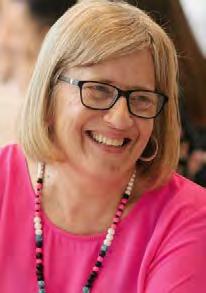
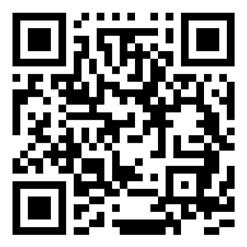
In Harmony with life, the new PX-S series continues to evolve.

The new Privia range takes its design & playability to new heights. The PX-S5000 is equipped with New Smart Scaled Hybrid Hammer Action Keyboard technology in its slim form. The mirror touch panel on the console, eliminates the need for numerous buttons, enabling the musician to fully focus on playing the instrument. The modern, compact design, which houses both battery and speakers, makes the instrument truly portable. Bluetooth connectivity allows you to also use the device as home audio equipment or as a remote control for expanded piano utility.

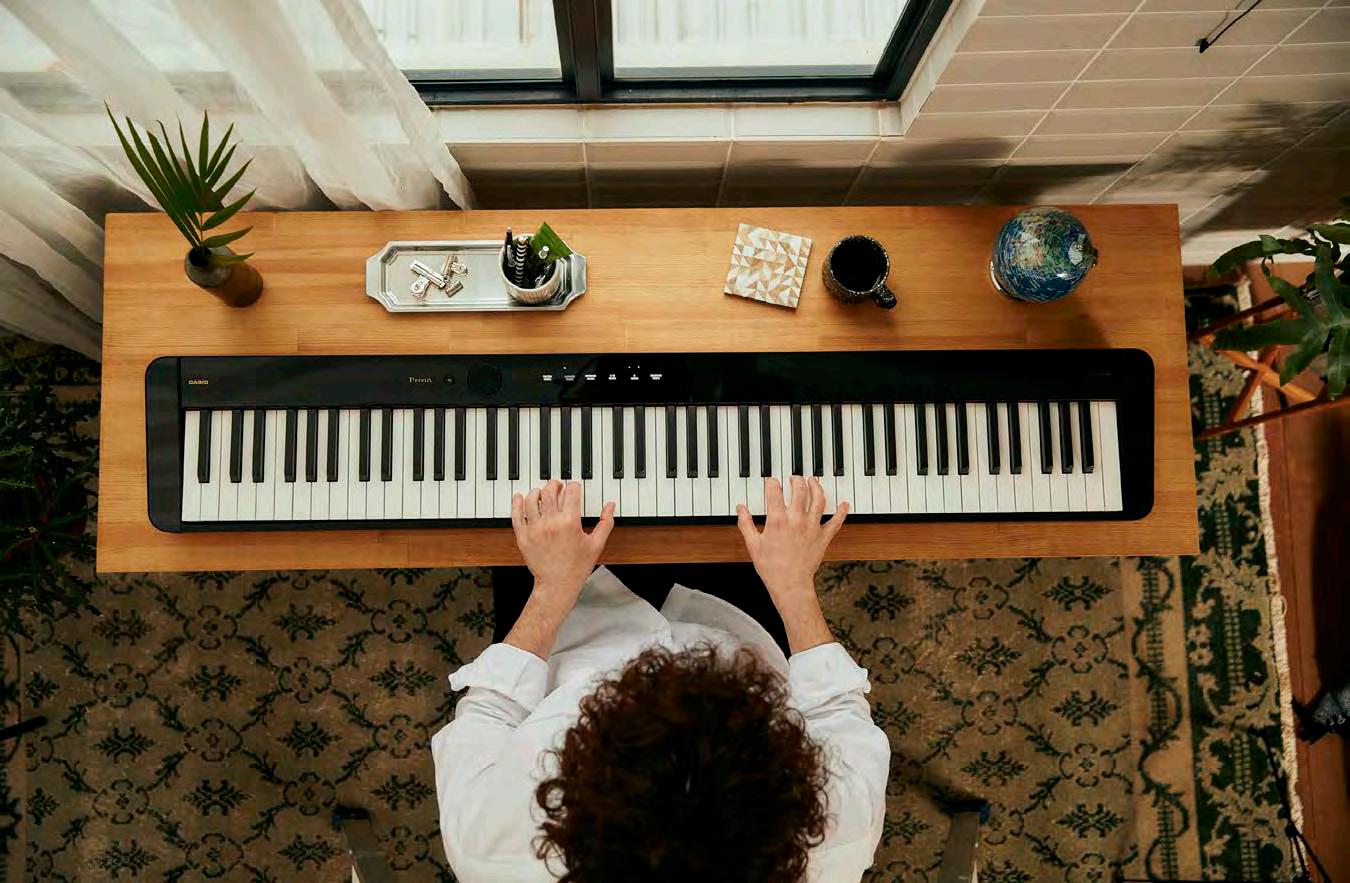
- 23 versatile tones; Multi-dimensional Morphing AiR sound source
- New Physical mechanism & Digital control technology
- New Smart Scaled Hybrid Hammer Action Keyboard technology

- Resin & Spruce hybrid mould, Ivory / Ebony textured key surface
- Optional 3-Pedal unit with continuous damper control (SP-34C2)*
- Two headphone inputs
- Bluetooth Audio & Remote control
- Two-way power supply, AC adaptor or Battery